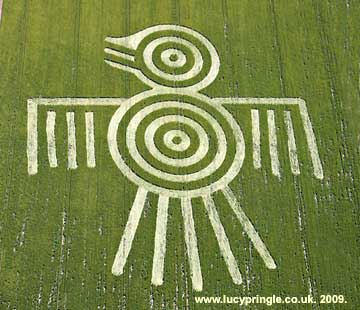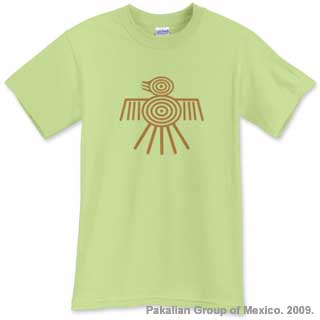| 6-10-09 - DREAM - I was in the backyard of my 16th St. house. We had a
really bad storm and the water froze under the shingles of the garage, which
raised them up really high (they were emerald green) The next morning, the
ice all thawed and the shingles started sliding off the roof. I was going
to run into the house to tell my Father about it, when I heard a strange noise.
And when I looked a huge baby eagle with its white baby feathers and a naked
neck and head flopped down onto the roof of the garage. This baby eagle
was about 2 feet long so I knew it was going to be a huge eagle when it was
grown. NOTE: This might relate to the grid shift
and alignment that is coming:
http://www.greatdreams.com/grid.htm
Also see:
http://www.greatdreams.com/poleshift.htm
and:
http://www.greatdreams.com/tuning.htm
Also note this:
The "Phoenix" is already stirring in its nest, deep
below the surface of our planet....
As it did 12,500 years ago, the Earth will readjust
the accumulating burden of ice in the polar regions which has thrown it
out of its delicately poised spinning balance.
In taking flight as the "Phoenix", the entire crust
of the Earth will break free of the weak, liquid bonds which hold it fixed
to the core of the earth. Briefly, the surface of our planet will slide
over its fluid bearings of molten magma 200-400 miles below the surface,
shifting the polar ice caps to the temperate zones where they will melt. A
great portion of the Earth's surface will be radically changed by severe
earthquakes, hurricane wind storms, and huge tidal waves.
This event was remembered by the ancient Egyptians as
the flight of the Phoenix. They built the Great Pyramid to memorialize the
last flight and transmit into our consciousness the certain knowledge that
it would come again. It is coming. The past will become the future.
***************
6-12-09 - DREAM - I was moving into a new apartment in a building where
we also worked and this apartment was the first floor between my female
boss and my male boss who was also her boss.
I wasn't quite done moving in yet, and was standing in the hallway with
a couple objects on which there was a large round ticking clock.
My male boss walked by and stopped to admire the clock which was
ticking quite loudly. I hoped he wouldn't notice that were late for work and when he admired the clock, I offered it to him
to put in his office and he accepted. I could always get another
clock and this clock seemed to please him. I pointed out to him that
the clock had some dust inside the body of the clock and that it would
need to be cleaned and he said he would take care of it. (I didn't
notice what time it was on the clock but it seemed very important to the boss
to have it so he walked away with it to his office)
Pink Floyd: Time:
http://www.youtube.com/watch?v=ntm1YfehK7U
More about Pink Floyd
Michael Jackson: Remember the Time
http://www.youtube.com/watch?v=nDxsM5jLNxM
Cindy Lauper: Time After Time:
http://www.youtube.com/watch?v=3C6AXnnjgqI
Billy Joel: The Longest Time:
http://www.youtube.com/watch?v=Smeyf8nhM5Q
Also see:
-
This article speaks of the number 432 that is found in
worldwide myths and religions.
Most often, it appears as a
time cycle number.
www.greatdreams.com/432.htm
Also:
http://www.greatdreams.com/ages.htm
and
http://www.greatdreams.com/2012.htm
I went into my apartment for a moment and saw that it had no furniture
and had some clothing in piles, but nothing was hung up. I wondered if I
would even be able to find my underwear.
My roommate was cooking a meal, and she needed something fixed and it
took a screwdriver. I asked her if she had a tool drawer in the
kitchen cabinet, and started opening all the drawers in the kitchen
looking for a tool drawer and saw that she had no tools whatsoever so we
couldn't fix whatever was broken unless we had a screwdriver.
The telephone rang then, and I answered it and there were two male
voices on the phone and it was hard to distinguish what each person
wanted, except one old man said he was depressed and that's why he decided
to call and he started to read a prayer - but I couldn't make out which
prayer it was or a Bible verse perhaps because the other man was talking
at the same time and I couldn't focus on either voice. Then my
roommate picked up the extension of the phone and started talking too, and
the old man must have hung up and I let my roommate talk to the remaining
man.
I walked down the hall to my female bosses office and saw that she was
working on some computations about electricity and a couple large monetary
numbers were highlighted in yellow highlighter. Another man walked
in who was in charge of electricity and she showed him her computations
and told him that she would pay half from one account and pay the other
half from another account. He seemed pleased that she had figured
out how to pay for it, and that pleased her that she had figured it out.
The number was really large - in the billions, and I wondered what people
were going to have to sacrifice so she could take 'their' money to pay the
electric bills.
The man had a notebook with him and on the page that was showing was a
series of doodles, and each doodle was the letter S in cursive writing and
each S was in a different shape, neatly drawn with three lines in the
letter S followed by the letters 'elf' in plain print (which makes
the word Self) and I wondered how many ways one could draw the
letter S in cursive and still have it be recognizable.

The man then turned the page and that page had a full page of doodles
of the sun that his uncle had done and each sun had a different size and shape and the last one
was really large and misshapen, and my female boss said to the man,
"Henry! I hope you aren't trying to be like your uncle Harold!"
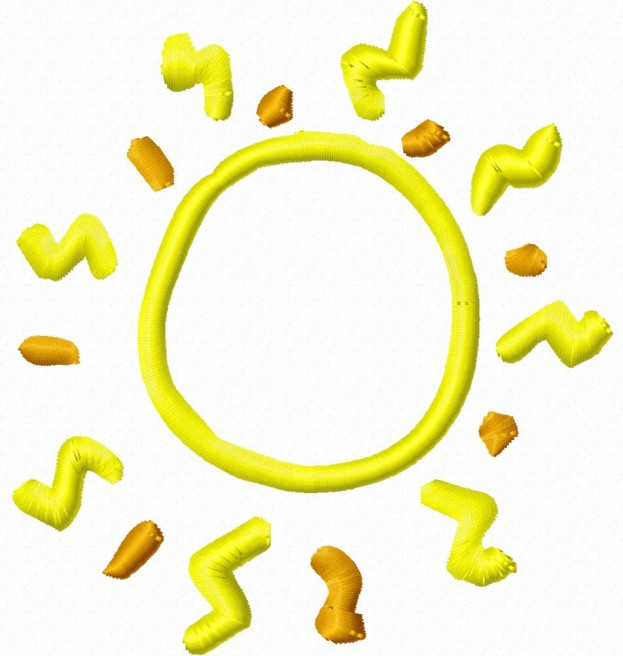 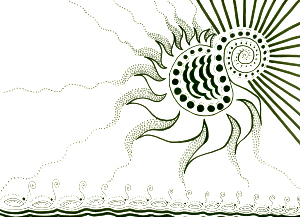 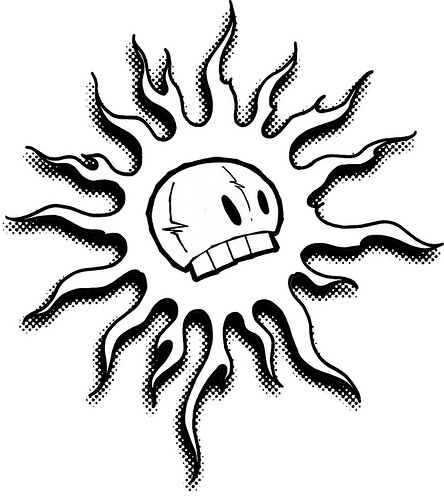
Henry said, "Uncle Harold was trying to prepare Humanity!........
and I woke up.
Joe suggested this might be about the Eagle of Zeus
which is the first thing I looked up, but an hour or so later, when I was
sitting on the sofa watching TV, all of a sudden, I got the thought "the
Storm Bird Zu".
The name Henry means:The boy's name Henry \he(n)-ry\
is pronounced HEN-ree. It is of
Old German
origin, and its meaning is "home
ruler".
Norman name
that is a favored
royal name (for
eight kings) of
England and
France.
The name Harold means:The boy's name Harold \ha-ro-ld\
is pronounced HARE-uld. It is of
Scandinavian
origin, and its meaning is "army
ruler".
Herald is
also literally "one who proclaims".
Photos above from google.com images
SUN DATABASE ON THIS SITE:
http://www.google.com/search?gbv=2&hl=en&q=site%3Agreatdreams.com++sun&aq=f&oq=&aqi=
THIS CAME IN TODAY - BUT HAS BEEN ONGOING THROUGH E-MAILS FOR AT LEAST
A WEEK:
From: Mahala G.
Subject: war in space
Date: Saturday, June 13, 2009, 2:37 PM
Hi Dee,
I had a dream on May 9, 2009 about the war that is going on in
space. It is quite awesome. I was on a ship watching the lazer
beams being fired at each other. Richard Hoagland said on
coast a couple of nights ago that they have put a block out on
any news regarding anything in space like space rocks, etc. He
also talked about the war in space. I wonder how long it will
continue.
Anyway, have a great day!
Mahala
Hi Mahala: I'm glad you dreamed about it because its true.
Steve Quayle announced on his radio show: (http://www.stevequayle.com) the other day that an object is coming in
from space that is 15 to 20 miles in diameter and it is coming
towards earth, changing trajectory and speed - and hordes of
scientists are rushing down to Antarctica to see what this thing
is. No more details were given - all that stuff is
classified now according to the article that came out just this
week after the object was spotted.No asteroid or comet
changes trajectories or speed unless it's intelligently guided.
I listened to Richard Hoagland talk about it just yesterday on the
coasttocoastam.com
archive, and I heard the other guy who was on a few weeks ago,
and he said he can see the
fighting up in space about 200 miles up with his infra-red
telescope. that was an awesome show to listen to also.
That is until I found out how those infra-red telescopes cost and I can't
afford to get one.
But, I had a dream about it too - war around the sun - that was
some time ago.
See:
http://www.greatdreams.com/sunstuff.htm
and:
http://www.greatdreams.com/warspc.htm
I hate to say it, but I've had many dreams about aliens
shooting lazer beams at people on the ground, not just in space,
but as long as the government refuses to talk about it, should
we worry????? How many pilots have we already lost in
space because nobody ever reports deaths like that.
A crop circle has appeared since I created this page, that
people are saying predicts bad things to happen with the sun
during the lunar eclipse of July 7, 2009
A crop circle has
appeared that researchers interpret to be a
message that the Sun is about to emit five
Coronal Mass Ejections (CMEs) that will hit
the Earth on July 7. The crop circle first
appeared at Milk Hill England on June 21 and
has
evolved over three stages up until June
30. Researchers interpreting the complex
images in the crop circle believe these
represent positions of planets that
correspond to July 6 and 7 as dates when
CMEs will hit the Earth. If so, this may be
the first barrage of CMEs to hit the Earth
in Solar Cycle 24. Importantly, scientists
will be able to directly study the impacts
of large amounts of solar plasma penetrating
a
breach in the magnetosphere first
reported by NASA scientists in December
2008.
NOTE: Thus far, according to
www.spaceweather.com there have
been no sunspots capable of delivering a CME
anywhere,, much less towards earth, but one
did appear on July 5, which is crackling
with x-rays, which are also worrying some
people.
Here is the crop circle. It was increased in size in three
phases and now looks like the second photo.
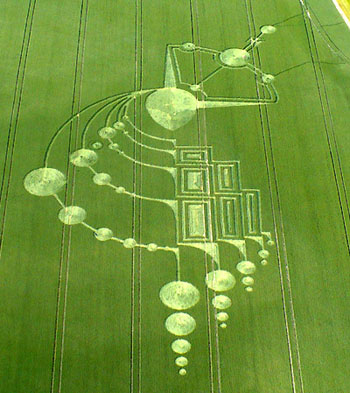 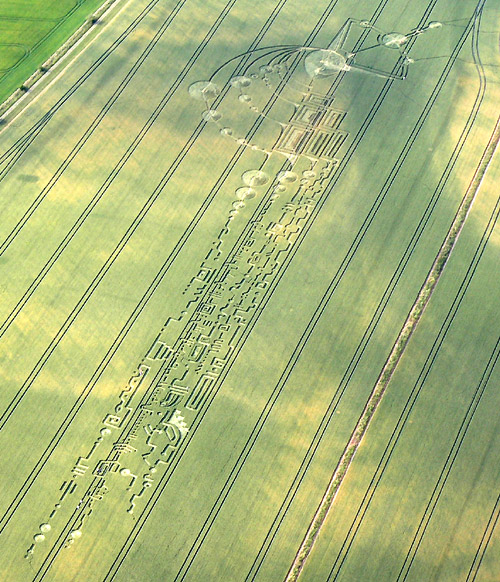
The long strings of glyphs below the main structure are said
to be Mayan numbers. Only an expert could determine
exactly what it says.
Here is the information about the eclipse.
The global visibility of this lunar eclipse is
shown in the diagram below.
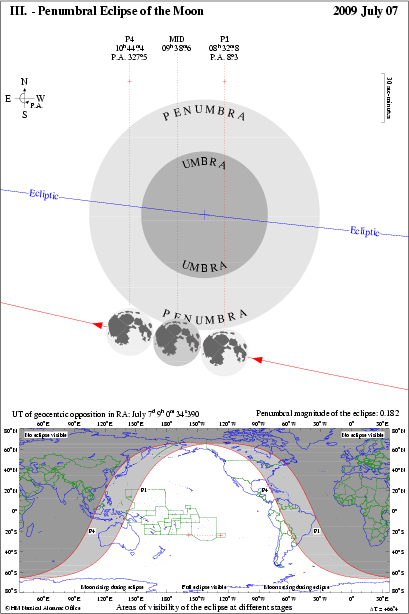
The Sun Bird or Phoenix
Edgar has "collected considerable evidence which
supports the theory that the ancient Egyptian 'winged solar disk'
symbol and the analogous Mesopotamian 'ring with wings' symbol were,
in all probability, inspired by ancient observations of total solar
eclipses. They were evidently inspired by the Phoenix bird aka 'Bird
of the Sun' that is readily perceivable within the sun's corona during
the total phase of some total eclipses of the sun. The diaphanous
equatorial streamers of the corona, which are most pronounced during
total solar eclipses that occur during years when the sunspot cycle is
at its minimum phase of activity, bear a remarkable resemblance to the
outspread wings of a glorious celestial bird while the plume-like
polar rays mimic the fanned-out tail-feathers of a bird. This
wing-like appearance of the equatorial streamers of the sun's outer
corona was first remarked upon by professional astronomers in the
latter half of the 19th century and it quickly became fashionable
amongst astronomers to refer to the sun's coronal streamers as
'wings'. The mythological Phoenix bird of classical Greek mythology
can be shown to have been inspired, at least in part, by the Bennu
bird heron god (Phoenix) of ancient Egyptian religion. There should be
very little doubt in modern minds that the enormous cosmic 'Sun Bird',
is the source of inspiration for many, if not most, mythical birds.
"Elmer G. Suhr, in his regrettably now out of print
book on eclipse lore 'The Mask, the Unicorn and the Messiah', clearly
recognized that total solar eclipses were the awe-inspiring celestial
phenomenon that, in all probability, originally inspired not only the
phoenixes of both the ancient Middle East and the Orient, but also the
garuda Sunbird of Indian religion and other mythical Sunbirds:
'There was perhaps no astronomical phenomenon more
startling to primitive and early civilized man than the total solar
eclipse. Without any warning by way of sound or sight he noticed an
eerie and untimely darkness settling over the land, and when he
looked at the sun, he saw a menacingly dark circle covered the
bright central area of light;
from the edge of the darkness a desperate flare of shooting
light heightened the dramatic effect of the experience, a flare
which tended to take on a feathery texture, so much more spectacular
in contrast to the dark centre; in an annular eclipse the light
takes on the form of a bright ring. Since the flare of the total
eclipse frequently reaches out farther on two opposite sides, the
Assyrians and Egyptians pictured this effect as the wings of a
mighty bird. The Chinese also developed the bird with outstretched
wings in their image of the sun. Then followed the creation of the
phoenix, the garuda of India and fanciful birds to represent the sun
itself.'
"The primary religious symbols of the ancient
Egyptians was the red sun disk. It represented the various Egyptian
sun gods including Ra. This sun disk was usually encircled by, or
rimmed on either side by, the 'ar'et serpent, also known as the uraeus
or 'fiery cobra'. The uraeus cobra was often depicted with a sun disk
perched on its rearing head to emphasize its association with the sun.
The sun's chromosphere could easily be perceived as a cosmic serpent
encircling the sun, with the flaming red solar prominences appearing
to the ancient Egyptians to be the rearing heads of flame-spitting
cobras. When elongated vulture wings, inspired by the equatorial
streamers of the corona, were added to the solar disk stretching out
on one or both sides, the sun disk became the 'winged disk'. According
to the book 'The Migration of Symbols' by Comte Eugene Goblet
d'Alviella, 'It has been said, with good reason, that the Winged Globe
is the Egyptian symbol par excellence. According to an inscription at
Edfu it was Thoth himself who caused it to be placed above the
entrances to all the temples in order to commemorate the victory won
by Horus over Set, i.e. by the principle of light and good over that
of darkness and evil.'
FROM: http://www.impossible.za.net/frames.htm?http://solar.eclipse.impossible.za.net/solar_eclipse_phoenix.htm&2
Solar eclipse of July 22,
2009
From Wikipedia, the free encyclopedia
The
solar eclipse that will take place on Wednesday,
July 22,
2009
will be a total eclipse of the
Sun
with a
magnitude of 1.080 that will be visible from a narrow corridor
through northern
India,
eastern
Nepal, northern
Bangladesh,
Bhutan, the northern tip of
Myanmar, central
China
and the
Pacific Ocean, including
Ryukyu Islands,
Marshall Islands and
Kiribati. Totality will be visible in many cities such as
Surat,
Varanasi,
Patna,
Thimphu,
Chengdu,
Chongqing,
Wuhan,
Hangzhou and
Shanghai, as well as over the
Three Gorges Dam. A
partial eclipse will be seen from the much broader path of the
Moon's
penumbra, including most of
South East Asia and north-eastern
Oceania.
This solar eclipse is the longest total solar eclipse that will
occur in the twenty-first century, and will not be surpassed in
duration until June 13, 2132. Totality will last for up to 6
minutes and 39 seconds, with the maximum eclipse occurring in the
ocean at 02:35:21
UTC about 100 km south of the
Bonin Islands, southeast of
Japan.
The
North Iwo Jima island is the landmass with totality time
closest to maximum.
-
Fred Espenak and Jay Anderson. "Total
Solar Eclipse of 2009 July 22".
NASA,
July 2004.
-
Kosmandu Astronomical Society 2009 Solar Eclipse in Nepal Page
See also
External links
ZEUS IS THE PROTOTYPE OF THE INDO-EUROPEAN SKY-GOD.
His name is derived from the Indo-European root meaning "to shine".
He is the cloud gatherer, the storm bringer, and the one who brings forth
rain from the sky. His symbol is the thunderbolt, and he has been
associated with the Babylonian Storm Bird Zu, the Hindu Gods Brahma, and
Indra, and the Roman Jupiter.
ZEUS AND HIS MESSENGER EAGLE
THE AETOS DIOS was a giant, golden eagle which
served as Zeus' personal messenger and animal companion. According
to some, the eagle was once a mortal king named Periphas, whose
virtuous rule was so celebrated that he was came to be honoured like
a god. Zeus, in anger, would have smote him with a thunderbolt, but
Apollon intervened and, transforming the king into an eagle, set him
beside the throne of Zeus. In other accounts, Zeus adopted the eagle
as his bird when it first appeared to him before the Titan War as a
sign of good omen. The eagle was later sent by Zeus to carry the
handsome youth
Ganymedes
up to heaven to become the cupbearer of the gods.
The bird
received a place amongst the stars as the
constellation
Aquila. Its consort was Lyra, the heavenly vulture.
GAIA
(Antoninus Liberalis 6)
PE′RIPHAS (Periphas). An Attic antochthon previous to the
time of Cecrops. was a priest of Apollo, and on account of his
virtues he was made king; but as he was honoured to the same
extent as Zeus, the latter wished to destroy him. At the request
of Apollo, however, Zeus metamorphosed him into an eagle, and
his wife likewise into a bird. (Anton. Lib. 6 ; Ov. Met. vii.
400.)
Although Zeus was well known for his dalliances with
various women (and thus infuriating his wife, the goddess
Hera), Zeus didn't limit himself to young women. At least once he
also fell in love with a young boy: Ganymede, son of King Tros of Troy.

Because Zeus found the young Ganymede so desirable,
he changed himself into and eagle and swooped down to abduct him. Zeus
carried the boy high up to Mt. Olympus and made him a cupbearer for the
gods. Hera, already annoyed that Zeus had found yet another mortal to
cheat on her with, was made even angrier by this last decision because
cupbearer was a position that had previously been held by her daughter
with Zeus, Hebe.
Zeus so loved Ganymede that he never wanted to be
without the boy's company and so created the constellation Aquarius, the
cupbearer, to commemorate their love. It is believed by some scholars
that this story was used to explain and/or justify the presence of
homosexuality in ancient Greece - in particular the homosexual
relationships that developed between younger males and older men.
ZZZ
THE AETOS DIOS was a giant, golden
eagle which served as
Zeus' personal messenger and animal companion. According to some,
the
eagle was once a mortal king
...
www.theoi.com/Ther/AetosDios.html
Ancient History question: Why does the
eagle symbolize
Zeus? because the
eagle symbolized authority from the sky.
wiki.answers.com/Q/Why_does_the_eagle_symbolize_Zeus
Ancient History question: Why is the
eagle a symbol of
Zeus?
Zeus is the father of gods/ goddesses and man kind and he rules the
sky, weather, law, ...
wiki.answers.com/Q/Why_is_the_eagle_a_symbol_of_Zeus
Although
Zeus was well known for his dalliances with various women (and thus
infuriating his wife, the goddess Hera),
Zeus didn't limit himself to young
...
atheism.about.com/library/FAQs/religion/blgrk_zeus11.htm
zeus helmet, war helmet, goddess of wisdom: Hello Dan, The statue
you describe is Athena. Only two goddesses were portrayed in a sitting
position.
en.allexperts.com/q/Mythology-658/Eagle-staff.htm
by D. J. Conway - 2005 - Body, Mind & Spirit - 253 pages
White
Eagle of Zeus The Greek god
Zeus had a special messenger he often used: a beautiful, gigantic
white
eagle whose feathers glowed.
...
books.google.com/books?isbn=1564148335...
Zeus' main attribute is the Thunderbolt, which he received from the
Cyclopes. The
Eagle is
Zeus' bird. An
Eagle was seen by
Zeus as an omen for attacking
...
www.library.csi.cuny.edu/siias/greekgods.html
Jul 3, 2006 ...
Zeus condemned Prometheus to having his liver eaten by a giant
eagle for giving the Flames of Olympus to the mortals.
...
NOTE: RECENTLY I
WROTE ABOUT BOTH THE SUN AND IT'S DANGERS AND APOLLO WHO IS VERY
PROMINENT IN THE BIBLE ESPECIALLY IN THE BOOK OF REVELATION
STORM BIRD ZU
In Sumero-Akkadian mythology, Zu is a divine storm-bird and
the personification of the southern wind and the thunder
clouds. This demon, half man and half bird, stole the
"Tablets of Destiny" from
Enlil and hid them on a mountaintop.
Anu
ordered the other gods to retrieve the tablets, even though
they all feared the demon. According to one text,
Marduk killed the bird, but in another text it died
through the arrows of the god
Ninurta. The bird is also referred to as Imdugud or
Anzu.
http://echoes.devin.com/watchers/pazuzu.html
Stela 60 of the
Mayans.depicts one of the Hero Twins standing over a fallen
Bird Deity. The carvings and orientation of Group A indicate
that this Bird Deity represents the Big Dipper to the north,
rising and falling over Tacana volcano. In the Maya Creation
Myth, the Big Dipper is Seven Macaw, the vain and false ruler
of the previous World Age. The Hero Twins facilitated his
downfall so that their father, One Hunahpu (a SOLAR lord),
could be resurrected. Given the viewing orientation of the
viewing seats and anyone standing in front of Stela 60, we are
justified in suspecting that the solar rebirth will be found
happening over the solstice horizon. And the December solstice
itself is the rebirth of the sun in the annual cycle. But the
Creation Myth, which is the subject of these carvings, is
concerned with the shifting of World Ages, implying we must be
sensitive to recognizing a much larger cycle of solar rebirth
(a new “Sun” or “Age”). >> [End of excerpt] The "fallen Bird
Deity" seemed coincidental. This seems to be the same as the
Sumerian/Babylonian, "Storm Bird Zu," who had stolen the
tablets with the fates of men. Marduke, who was given the
title, "Lord," was the demiurge hero who chased down the Storm
Bird Zu and retrieved the tablets.
In the earlier version, it
was apparently Marduk's father, Ea/Enki, who defeated the
Storm Bird Zu. This bird actually looks like a man with wings,
i.e., the prototype for Satan.
See Pazuzu below
From:
http://www.greatdreams.com/432.htm
Great Central
Valley
September, 1993
After composing a hand-written essay
about my experiences, and sending copies two weeks ago to John
Crowe, of the COSMINAR organization in Essex, England, and two
other people, I am now surprised to read that a crop formation
appeared called the
Bythorn Mandala.
I recognized it immediately as one of the
symbols in
Tantric Way: Art, Science, Ritual. It is on page 35,
and called a "Shyama
(Kali) Yantra." The crop formation is not exactly like the
one in the book, but it is quite similar. The one in the book
is similar to the Sri Yantra, except there is a five-pointed
star inside instead of the complex pattern of overlapping
triangles. The inner part is quite like the crop formation,
except the crop formation had ten petals instead of eight, as
in the book. The five-pointed star in the crop formation was
inside a pentagon. This is very similar to the symbol of the
third chakra,
which is represented by a ten-petal lotus flower. This may be
related to the ten horns of the beast in Revelation 17, as the
harlot clearly has the
same meaning
as Kali.
Kali evokes the feeling of
tamasisk,
which means fury. The kings of the earth become drunk on the
wine of the harlot, which causes fury. In dreams the fury is
often symbolized by a storm. In the Babylonian myths, the
demiurge hero, Marduke, chased down the Storm Bird, Zu, who
had stolen the tablets with the fates of men, and retrieved
the tablets. In other words, the anger causes one's fate to be
controlled from elsewhere. Birds, according to Joseph
Campbell, symbolize the descent of the Deity into the field of
time. Nowadays, I think, such birds can be represented by
airplanes.
My dreams indicate that the demiurge
gods, such as Marduke, represent the consciousness gestalt of
mankind, sometimes symbolized by the swastika. The myth of
Marduke and the Storm Bird suggests that eventually the human
race will overcome the problem of having their fates stolen
via the storm of anger.
FROM:
http://www.greatdreams.com/Events/9_11_01/Amertrag.htm
See also: KALI:
http://www.greatdreams.com/kali.htm
and:
http://www.greatdreams.com/sacred/age_kali.htm
and:
http://www.greatdreams.com/anger.htm
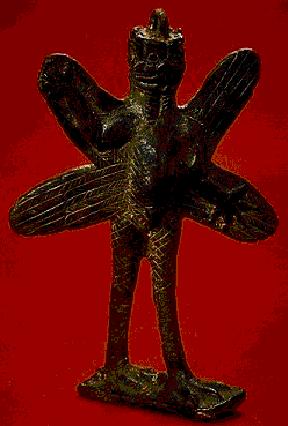
PAZUZU - ZU - ANZU
Sumer/Babylon: Pazuzu
Not much is known about Pazuzu -- or Zu, as he is sometimes called.
According to
one
web site, "This little-known demon from Babylonian myth was
represented as a very thin, emaciated man with the feet and wings of
an eagle, and the forepaws and head of a lion. He is nearly always
shown with the right paw raised and the left held at his side.
"The
demon first appeared in early Babylonian myth in the guise of the
'storm-bird' Zu, who stole the Tablets of Destiny from the dragoness
Tiamat. In the later Babylonian civilization, he once again appeared,
this time under the name of Pazuzu, and was said to be the child of
the chief wind-demon, Hanpa. When Pazuzu is summoned by worshippers,
he appears in a statuesque form, frozen into the position described
above. However, he metamorphoses out of the statue form to his living
form. In this form, he is fully capable of movement."
The Yezidi tribes of Kurdistan, who worship a Watcherlike god
called Malek Taus, or the
Peacock Angel,
tell a very similar story to the one about Zu and Tiamat. In their
mythology, a creature -- who is half-lion, half-eagle -- called
Imdugud, or Anzu.
"This monster was said to have stolen the Tablets of Destiny from the
god Enlil (Ellil) in Akkadian which, in its possession, gave 'him
power over the Universe as controller of the fates of all,' enough to
endanger 'the stability of civilization,'" Andrew Collins writes in
his book "From the Ashes of Angels."
According to wikipedia, "Although Pazuzu was a malevolent force,
his image was used on amulets to ward off his enemy Lamashtu, a female
demon that preyed on newborn babies and their mothers. The amulet was
either placed on the mother or child or larger ones were placed above
them on a wall."
In his
essay, "The Demon of the South-West Wind," Stephen Sennitt writes,
"In his erudite book, 'The Domain of Devils,' Eric Marple describes
the wind demon as the most terrible of all demonic entities, having
the power to spread loathsome diseases with his dry, fiery breath. The
demo has 'for a head the almost fleshless skull of a dog,'
representing death, disease, and as the fleshless death's-head of the
desert scavenger, starvation. Significantly, william Woods states in
his 'History of the Devil,' 'in Mesopotamia, the horned demon, Pazuzu,
rode on the wind and carried malaria,' thus emphasizing the demon's
destructive role as 'lord of fevers and plagues.'"
It is interesting to put Pazuzu alongside Watcher myths, and
compare his protectiveness of women, as well as his ability to bring
massive plagues, to the Watchers story in the Book of Enoch.
THE FOLLOWING PHOTOS AND ARTICLES ARE FROM EBAY.COM SALES PAGES.
THESE STATUE COPIES ARE AVAILABLE FOR SALE THERE.
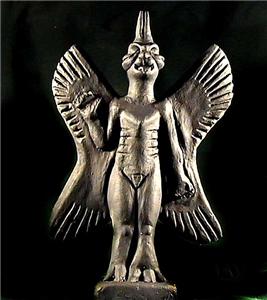
PAZUZU
DEMON
Stone-cast statue, black hydrostone, 210
mm tall (8.25") 130 mm wingspanZ
Reproduction of the ancient
Sumerian-Babylonian tomb guardian
Pazuzu, elemental
demon of wind and pestilence. As
archetypal monster, it incorporates a
composite of astrological
characteristics and is portrayed with
horns, serpentine face, the wings of an
eagle, the legs and paws of a lion and
scorpion tail.
The
oldest of all demons, Pazuzu is first to
appear in the Western tradition and
responsible for a plethora of demons,
devils and genies in the cultures which
follow.
HISTORICAL BACKGROUND
As
personification of the "evil wind that
brings pestilence," Pazuzu is one of the
famous Seven Sumerian Demons dispatched
upon a hapless earth by the celestial dragononess Tiamat
during her epic battle with the solar
deity Marduk. In the
form of the Demon Storm-Bird Zu,
Pazuzu achieved heroic status for
stealing the Tablets of Destiny from
Tiamat. According to the Sumerian
chronicles, the Seven Demons represent
the elemental forces which assaulted the
world during the terrible cataclysm
attending the Great Flood.
Because tradition held that Pazuzu once
opposed a powerful demonic goddess,
icons of Pazuzu were used for warding
off all evil forces. Until late
Babylonian times, Pazuzu was worn as an
amulet, set on household shelves and
placed next to sleeping children to
guard them from Lamashtu, a female demon
who preyed upon babies and their
mothers.
Statuettes like this were also left in
tombs to protect the dead which, at the
same time, conferred a relative
immortality on the benevolent demon.
Pazuzu’s protective presence on the
eaves of ancient temples is still echoed
today by the misshapen winged
gargoyles clutching the
roof-tops of Medieval churches and
Gothic buildings.
TABLETS OF DESTINY
In
Mesopotamian
mythology, the Tablet of
Destinies (not, as frequently
misquoted in general works, the
'Tablets of Destinies') was
envisaged as a clay tablet
inscribed with
cuneiform writing, also
impressed with
cylinder seals, which, as a
permanent legal document,
conferred upon the god
Enlil his supreme authority
as ruler of the universe.
In the
Sumerian poem
'Ninurta and the Turtle' it
is the god
Enki, rather than Enlil, who
holds the tablet. Both this poem
and the
Akkadian
Anzû poem concern the theft
of the tablet by the bird
Imdugud (Sumerian) or
Anzû (Akkadian). Supposedly,
whoever possessed the tablet
ruled the universe. In the
Babylonian
Enuma Elish,
Tiamat bestows this tablet
on Qingu (in some instances
spelled "Kingu")
and gives him command of her
army.
Marduk, the chosen champion
of the gods, then fights and
destroys
Tiamat and her army. Marduk
reclaims the Tablet of Destinies
for himself, thereby
legitimating his rule among the
gods, but turns it over to Anu
as a gift in Tablet V of the
epic.
The tablet
can be compared with the concept
of the
Me, divine decrees.
FROM
LOSTHISTORY.COM IS THIS:
Zeus - [ENKI] Steals
the Tablets of Destiny
It appears that
Ensuhgirana wasn't as
complacent as he let on
because another tale,
Lugal-Banda in the
Mountain Cave, also
called Lugal-Banda and
Mount Hurrum, begins
with Enmerkar preparing an
expedition against Aratta,
"the mountain of the holy
divine powers", for
rebelling against him. The
troops wait for five days
before they enter the
mountains, on the sixth
day they washed to purify
themselves, and on the
seventh day they entered
the mountains. Half way
there his eighth general,
Lugal-Banda, got a
sickness in the head that
caused him to jerk around
like a gazelle caught in a
snare. He began to slow
them down; they wanted to
bring him back to Uruk,
but didn't know how they
could, so they found a
mountain cave and made a
camp for him. They left
him an axe and a dagger,
plenty of food and beer
and suspended some incense
and other healing resins
around his head, but Lugal-Banda
soon become unresponsive.
His brothers counseled
each other, saying that if
he rises again like Utu
the sun god, then the food
would help him walk again
and maybe enable him to
journey back to Uruk, but
if Utu called their
brother to the holy
"valued" place, then it
would be up to them to
carry his body on their
journey back. Then the men
left.
For two days he sat and
perspired heavily, then he
began to cry, telling Utu
that there was no one
there to feel sorry for
him and asking that he not
die lost in the mountains
like a weakling. Utu
accepted his tears and
sent down some divine
encouragement. Inanna
appeared before Lugal-Banda
and the general began to
cry as if before is own
father. Inanna accepted
his tears and enveloped
him like a woolen garment,
then disappeared back to
Uruk. The moon then came
out an illuminated the
cave and Lugal-Banda cried
out to the moon god's
sense of justice and
hatred of evil. Suen (Nanna)
accepted his tears as well
and Lugal-Banda was able
to walk. The next day he
praised Utu and the moon
god's wife Ningal before
leaving the cave. Thanks
to a god who took council
with Enlil (probably Utu
or Ningal) life saving
plants began to grow and
life saving water started
to flow from the hills'
rivers. Lugal-Banda then
left the cave to hunt for
food. While out he started
a fire by striking two
stones together. Then,
without even knowing how
to bake cakes with an
oven, he baked some dough
and garnished it with
syrup from some roots he
stripped. He then caught a
wild brown bull and two
goats either by trap or
ambush. Then, with the
help of some beer and
white linen sheet, he went
to sleep:
The king lay down not
to sleep, he lay down to
dream -- not turning back
at the door of the dream,
not turning back at the
door-pivot. To the liar it
talks in lies, to the
truthful it speaks truth.
It can make one man happy,
it can make another man
sing, but it is the closed
tablet-basket of the gods.
It is the beautiful
bedchamber of Ninlil, it
is the counselor of
Inanna. The multiplier of
mankind, the voice of one
not alive -- Zangara, the
god of dreams, himself
like a bull, bellowed at
Lugal-Banda.
Zangara
told him in his dream to
sacrifice the bull and
goats and to pour out the
blood so that the snakes
could smell it, so when
Lugal-Banda awoke he
wrestled the bull to the
ground and did just that.
The best parts of the bull
were burned so that An,
Enlil, Enki and Ninhursag
could feast on them.
At this point the text
becomes more and more
fragmented. Following this
there is a description of
some demons:
They are gazelles of Suen
running in flight, they
are the fine smooth cloths
of Ninlil, they are the
helpers of Ishkur; they
pile up flax, they pile up
barley; they are wild
animals on the rampage,
they descend like a storm
on a rebel land hated by
Suen, indeed they descend
like a storm.
It is also said that these
helpers of Ishkur sing out
in the dead of night,
sneak into homes to nestle
at peoples' bedsides, and
tie door pivots together.
The story then moves on to
the elders of city, who
seem to have been able to
enter the presence of the
Anunnaki to confirm the
power of the foreign
lands. Then there is
mention of 14
torch-bearers standing in
battle. They pursue like
wildfire, flash together
like lightning and roar
loudly like a great flood
rising up in the storm of
battle. Seven of these men
are favored by Inanna, who
wears a crown under a
clear sky, and they stand
proudly in battle as the
holy shining battle-mace
of An reaches to the edge
of heaven and earth. Utu,
who is called "the just
god who stands alongside
men", then walks out from
his chamber. There is then
some dialogue regarding
evil gods with evil hearts
who are the interpreters
of spoken evil and spy on
the righteous gods. Here
the text of the first
segment ends and it is
unknown if the second
undecipherable segment of
the tablet belongs to the
same composition or not,
but the story is continued
in another text.
Lugal-Banda and the
Anzu bird,
alternatively known as
Lugal-Banda and Enmerkar,
opens with Lugal-Banda
still lost deep within the
Zabu mountains. He gets an
idea to go and talk to the
Anzu bird and to treat him
and his wife respectfully.
He figures that An will
fetch Ninkasi, the beer
goddess, who will help him
get the Anzu bird drunk so
that it can help him find
his brothers, the troops
of Uruk.
There are references to
the Anzu bird in the other
two stories of Enmerkar,
but this is the first one
that goes into detail
about it. It is described
as having sharks teeth and
eagle's claws and is so
huge it hunts bulls. Its
cry is said to shake the
mountains and most likely
represents thunder. This
is most likely the origin
of the mythical roc of
Persian and Arabian lore.
In the Sumerian language,
Anzu was spelled Imdugud;
it was only later found
that it's name was
pronounced Anzu, or Zu. In
Babylonia and Assyria they
were believed to be wind
demons called Pazuzu (one
of which who made an
silhouette appearance in
The Exorcist).
While the Anzu bird is
away hunting, Lugal-Banda
sneaks into it's nest and
carefully makes celestial
cakes for it's chicks. He
then paints their eyes and
puts crowns on their
heads. When the chicks'
parents come home, they at
first think that someone
stole the chicks and cry
out so loudly that the
noise reaches up to the
gods and below to the abzu.
But when they see how the
chicks have been exulted,
he cries out:
" I
am the prince who decides
the destiny of rolling
rivers. I keep on the
straight and narrow path
the righteous who follow
Enlil's counsel. My father
Enlil brought me here. He
let me bar the entrance to
the mountains as if with a
great door. If I fix a
fate, who shall alter it?
If I but say the word, who
shall change it? Whoever
has done this to my nest,
if you are a god, I will
speak with you, indeed I
will befriend you. If you
are a man, I will fix your
fate. I shall not let you
have any opponents in the
mountains. You shall be
'Hero-fortified-by-Anzu'."
Lugal-Banda makes his
appearance and "partly
from fright, partly from
delight" begins flattering
the giant bird. He starts
telling them that they're
eyes are sparkling and how
their wingspan is like a
bird net stretched across
the sky. He says that
yesterday he escaped
safely because of the Anzu
bird and so leaves his
destiny in their hands,
naming the Anzu bird
father and the bird's wife
mother. Anzu then tries to
get out of the promise he
gave and offers several
bargains in exchange: a
boatload of precious
metals and food, the power
to shoot arrows that never
miss, the Lion of Battle
helmet (which gave courage
to it's wearer) and
finally the Milk of
Dumuzi. To each of these
offers the author replies:
"Lugal-Banda who loves the
seed will not accept
this." Apparently, being
'Hero-fortified-by-Anzu'
is not a power to be
trifled with because the
Anzu bird is worried about
living up to his word and
giving it to Lugal-Banda,
saying that an ass should
be kept on the straight
path.
Lugal-Banda the pure
answers him: "Let the
power of running be in my
thighs, let me never grow
tired! Let there be
strength in my arms, let
me stretch my arms wide,
let my arms never become
weak! Moving like the
sunlight, like Inanna,
like the seven storms,
those of Ishkur, let me
leap like a flame, blaze
like lightning! Let me go
wherever I look to, set
foot wherever I cast my
glance, reach wherever my
heart desires and let me
loosen my shoes in
whatever place my heart
has named to me! When Utu
lets me reach Kulaba
[Uruk] my city, let him
who curses me have no joy
thereof; let him who
wishes to strive with me
never say "Just let him
come!" I shall have the
woodcarvers fashion
statues of you, and you
will be breathtaking to
look upon. Your name will
be made famous thereby in
Sumer and will redound to
the credit of the temples
of the great gods."
Anzu gives in and bestows
his powers on Lugal-Banda,
at least satisfied that
Lugal-Banda will have
wooden idols of him carved
out for the Sumerians. The
Anzu bird then helped
Lugal-Banda find his
troops but told him not to
say anything about him or
the fate he fixed on him.
When Lugal-Banda gets back
to his brothers, we learn
that he was abandoned as
killed in battle. They ask
how he was able to survive
and cross the rivers and
Lugal-Banda just replies
that he walked over them
or drank them. His
companions then embrace
and kiss him and give him
food and drink. The troops
then moved on, following
the river until they
finally reached their
target: Aratta.
The army put the city
under siege for an entire
year. Enmerkar, the leader
of the troops is well
worried about it and can't
find anyone who wants to
go back to Uruk because
they're all afraid they'll
get lost, but then Lugal-Banda
volunteers. Enmerkar makes
him swear by heaven and
earth that he will go
along and not drop any of
their great emblems.
Enmerkar then summons an
assembly and begins to
question himself and the
goddess Inanna in front of
them:
" My troops are bound to me
as a cow is bound to its
calf; but like a son who,
hating his mother, leaves
his city, my princely
sister Inanna the pure has
run away from me back to
brick-built Kulaba [Uruk].
If she loves her city and
hates me, why does she
bind the city to me? If
she hates the city and yet
loves me, why does she
bind me to the city? If
the mistress removes
herself from me to her
holy chamber, and abandons
me like an Anzu chick,
then may she at least
bring me home to
brick-built Kulaba: on
that day my spear shall be
laid aside. On that day
she may shatter my shield.
Speak thus to my princely
sister, Inanna the pure."
Lugal-Banda's brothers ask
to join him on his journey
but he refuses despite
great insistence.
Lugal-Banda crossed the
seven mountains and at
midnight entered the
temple of Inanna and
prostrated himself before
her offering table. Inanna
asked why he had come all
alone form Aratta.
Lugal-Banda recites
Enmerkar's depressing
soliloquy and Inanna tells
him that if Enmerkar
catches the tamarisk, a
type of freshwater fish,
and sacrifices it, the
a-an-kara weapon, Inanna's
battle-strength, will be
given to his army and that
will put an end to the
subterranean waters that
give strength to Aratta.
Inanna finishes saying,
"If he carries off from
the city its worked metal
and smiths, if he carries
off its worked stones and
its stonemasons, if he
renews the city and
settles it, all the moulds
of Aratta will be his."
With the solution found,
the text ends with a
praise for Lugal-Banda.
The open-ended finish to
the story seems to
indicate that there is a
third text that concludes
the epic. It has been said
that Lugal-Banda is
supposed to kill the Anzu
bird but this may be an
assumption since
Lugal-Banda's name is
inherited by a god who
also meets up with an
Anzu.
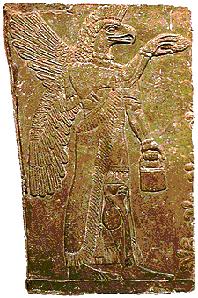
An Anzu bird (?)
picking fruit from the
Tree of Life
The Anzu bird takes on a
much more negative role in
Akkadian Myth of Anzu.
The text begins with
praises for Ninurta,
already revealing that he
defeated Anzu and also
saying that he defeated
the bull-man inside the
sea and raised a dais for
the lesser Igiggi. Enlil
and Enki watch the Anzu
bird, whose wings bring
the South Wind, and whose
body was like 11 coats of
mail. Enki concluded that
it had been conceived from
the holy abzu and
born out of the broad
earth and suggested that
it serve Enlil. Enlil made
the Anzu an extra fate and
appointed him the guardian
of his chambers. This
included guarding over the
Tablets of Destiny, which
gave Enlil the power to
decree fate. These tablets
identify Enlil as the
current head of the
pantheon instead of the
heaven god. The air god
seems to have replaced An,
or Anu (His Akkadian
name), sometime around
2500 B.C. Although earlier
stories tell of the
Tablets of Destiny giving
Anu-power, the tablets
here are said to confer
Enlil-power.
Every day the Tablets of
Destiny tempted the storm
bird, so one day while
Enlil was bathing in the
holy waters, Anzu stole
the tablets and flew off.
Enlil's chamber was
stripped of it's radiance
and silence reigned. Enlil
summoned his son Adad, or
Hadad, the Akkadian name
for Ishkur. But the
"controller of the canals"
only told his father that
the Anzu was now
undefeatable and that the
gods would have to tremble
at his utterance from now
on. The gods next proposed
Gerra, god of fire and the
son of Anu, and then
Shara, the son of Ishtar
(Inanna), but both of them
repeated Adad's refusal.
Enki suggested that they
let him pick the Anzu's
conqueror and the Igiggi
kissed his feet for taking
up the cause. He called
Mami (Ninmah) and just
like in the Akkadian
Creation story asked that
her name be changed to
Mistress of all the Gods.
Enki asked the birth
goddess if she would allow
her most beloved son,
Ninurta, to do the task.
She agreed and the gods
rejoiced at her decision.
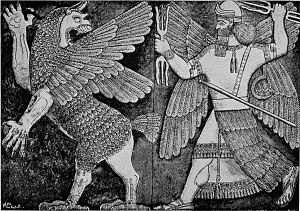
Ninurta attacks the
Anzu bird
The second tablet opens
with a long soliloquy
about poisoning arrows and
slitting the throat of
Anzu. Ninurta marshaled
the "Seven of Battle",
which are said to be the
seven evil winds. He and
Anzu met on a mountainside
and the storm bird bared
it's teeth and insolently
shouted, " I have taken
away every single rite,
and I am in charge of all
the gods' orders! Who are
you, to come to do battle
against me? Give your
reasons!" Ninurta replied
that he was the avenger of
Enlil, who established the
temple of Duranki ("Bond
of Heaven and Earth") in
Nippur. The Anzu caused
darkness to fall on the
mountain and Ninurta began
shooting arrows at him,
but using the Tablets of
Destiny, it caused the
arrows to turn back into a
reed, or the feathers back
into birds, or the
bowstring string back into
a ram's gut. Using his
magical mace Shurur,
Ninurta contacts Enki, who
relays a plan to him. Enki
then promises that once he
defeated the Anzu his
worship would be
established over the four
quarters. When Ninurta
hears this, he brought out
the "Seven of Battle", the
seven evil winds, and the
gales went silent.
The first three lines of
the third tablet are
fragmentary but the story
returns with both
combatants bathed in the
sweat of battle. The Anzu
grew tired as Enki
predicted and Ninurta
follows his instructions
precisely. When the Anzu's
wings slump down in
fatigue, Ninurta cuts them
off. Just as the Anzu
wishes for his wings to
grow back, Ninurta lets
loose an arrow at it's
heart. The feathers on the
arrow grow and pierce it's
heart and lungs, killing
it. Ninurta got back the
Tablets of Destiny and the
wind carried the great
bird's feathers as a sign
of good news. Ninurta
returns the Tablets of
Destiny and for slaying
the mountain is given
complete dominion and
every single rite. Among
the 15 titles that are
bestowed upon him are:
Duku ("Holy mound" in
Sumerian), Hurabtil (an
Elamite god), Shushinak
(patron god of the Elamite
city Susa), Zababa of
Kish, the warrior Tishpak,
and also Lugal-Banda. The
text ends going through a
long list of aliases
Ninurta is known by
throughout the lands.
This legend seems to be
designed as a response to
the belief that Enlil had
been replaced as king of
the gods. The account is
paralleled in the creation
story of the Greeks.
Though there are something
like six accounts of how
the Greek gods were born,
probably the most popular
account is from
Theogony, written by
the Greek poet Hesiod, who
lived sometime around the
600 or 700s B.C.:
In the beginning there was
only Chaos, the oldest of
the gods, a shapeless mass
of darkness and
meaninglessness, said to
be formed out of mist. Out
of the Chaos came Nyx
(Night; a great black
bird), Erebus (Primeval
abyss) and Tartarus. Nyx
and Erebus joined and Nyx
laid an egg that hatched
into Eros (Cupid; Love).
From Eros came Light and
Day. Once there was Light
and Day, Mother Earth, or
Gaea, appeared. The Greeks
pronounced her name Ge;
easily comparable to Ki,
the Sumerian earth mother.
The Romans called her
Terra, from which we get
the words terran and
terrain.
Uranus, the god of
heaven, was born of Gaea
as she slept. He became
her husband, and together
they had many children.
Their first-born children
were hecatonchires,
monsters with 50 heads and
100 hands, and the
cyclopses, giants with one
eye. The second born
children were the titans.
Uranus feared that his
powerful sons might topple
him from his position as
Lord of the Universe so he
cast the titans and
hecatonchires into
Tartarus, an underworld as
far from Earth as Heaven
was. Gaea was upset that
Uranus had imprisoned them
so she turned for help to
her youngest, Chronos
("Chronology"), god of
time and the upper sky.
Chronos hated his father's
evil deeds as much as his
mother so he ambushed his
father while he was making
love to the earth,
castrated him with a
jagged sickle, and threw
his genitalia into the
sea. This mixed with the
sea water to create
Aphrodite (Inanna), who is
attended by Eros and
Desire as well as some
other goddesses as she
enters the assembly of the
gods. In other myths
Aphrodite was the mother
of Eros. The blood from
the wound created the
Erinyes (Furies), Giants,
and Melian nymphs. After
this more violent
separation of Heaven and
Earth, Chronos takes his
place as Lord of the
Universe.
The era that Cronus ruled
was called as the Golden
Age, but that was not
because the gods were
peaceful and just. The
Titans ("Strainers") were
so named because Uranus
believed that they
wrongfully inflected
terror and would one day
pay for it. (Outside of
Theogony, it has also been
said that Ti-ta-an can be
read "Those who live in
Heaven" in Sumerian.) Nyx
then gives birth to
hateful Doom, black Fate,
Death, and she bore Sleep
and the tribe of Dreams.
And though she lay with no
one, Nyx give birth to
Blame, Woe, the Hesperide
nymphs, the Destinies, and
the three ruthless Fates:
Clotho the Spinner, who
spins the thread of man's
life; Lachesis, Disposer
of Lots, who assigns each
man his destiny; and
Atropos, who cuts the
threads of life. The three
Fates gave men at their
birth both good and evil
to choose from. Nyx also
gave birth to Nemesis
(Indignation), Deceit and
Friendship, hateful Age,
and hard-hearted Strife.
Strife bore Toil,
Forgetfulness, Famine,
Sorrow, Fighting, Battles,
Murders, Manslaughters,
Quarrels, Lying Words,
Disputes, Lawlessness,
Ruin and the worst of all
Oath, who troubles those
who swear falsely.
Theogony then goes
into a long list of gods,
heroes, and monsters with
paternities and short
biographies.
Gaea was sorely
disappointed to discover
that Chronos had no
intention of releasing his
100-handed brothers from
their dark prison. Chronos
married the titan Rhea and
together they had Demeter,
Hestia, Hera, Poseidon,
and the pitiless Hades.
Uranus and Gaea prophesied
his own son would dethrone
him so each time Rhea gave
birth Chronos swallowed
the newborn god.
Determined to protect her
sixth child from his
father, Rhea gave birth in
secret. She named the
infant Zeus and sent him
to the island of Crete, to
be raised by nymphs. Then,
pretending to obey her
husband's command, Rhea
wrapped a stone in a
blanket and carried it to
Chronos, who swallowed it
without any notice. When
Rhea thought Zeus was
strong enough to challenge
Chronos, she told him
about his five brothers
and sisters trapped inside
his father's body and how
he narrowly escaped the
same fate. With the help
of Gaea, Zeus forced his
father to regurgitate his
five brothers and sisters,
as well as the stone
(which was taken to
Delphi). His children, who
were led by their youngest
brother, Zeus, waged war
against him. However,
Chronos was backed by most
of his brothers and
sisters, the titans. The
war between the Olympians
and the Titans was so
terrible that it nearly
destroyed the universe.
When the titan Prometheus
("Forethought") could see
that Zeus and his siblings
were destined to win this
war against Chronos, he
abandoned his brothers and
sisters and joined Zeus.
He secretly advised the
storm god to release
Gaea's first-born
children, the
hecatonchires, informing
him that they wielded
thunder, lightning, and
earthquakes as weapons.
Once released, the
monsters fought against
Chronos and defeated the
titans. Like Enlil,
Chronos was then banished
deep within the bowels of
the earth. The other
titans were imprisoned in
the netherworld, called
Tartarus, as well,
although Chronos was able
to take rule over the
Elysian Fields, where the
nicer parts of Tartarus
was. Zeus, impressed by
the effectiveness of the
monsters' weapons,
appropriated the thunder
and lightning for his own
use. The Olympians then
chose the cloud-draped
summit of Mt. Olympus to
be their home.
But Mother Earth then gave
Zeus another problem to
contend with:
Now after
Zeus had driven the Titans
out of heaven, gigantic
Gaea, in love with
Tartarus, by means of
golden Aphrodite, bore the
youngest of her children,
Typhoeus; the hands and
arms of him are mighty,
and have work in them, and
the feet of the powerful
god were tireless, and up
from his shoulders there
grew a hundred snake
heads, those of a dreaded
dragon, and the heads
licked with dark tongues,
and from the eyes on the
inhuman heads fire
glittered from under the
eyelids: from all his
heads fire flared from his
eyes' glancing; and inside
each one of these horrible
heads there were voices
that threw out every sort
of horrible sound, for
sometimes it was speech
such as the gods could
understand, but at other
times, the sound of a
bellowing bull, proud-eyed
and furious beyond
holding, or again like a
lion shameless in cruelty,
or again it was like the
barking of dogs, a wonder
to listen to, or again he
would whistle so the tall
mountains re-echoed to it.
This monster was so great
that Olympus shook when he
walked and even the
imprisoned Titans were
shaken up as the giant
walked on top of the
earth. But Zeus attacked
the monster with his
thunderbolts and set the
dragon heads on fire.
According to the Greek
poet Apollodorus, Zeus
chased the monster with a
sickle made of Adamant
(Diamond). Typhoeus ran to
Mount Casius (near Antioch
in Syria), where Zeus fell
on him, thinking he was
badly wounded. Typhoeus
then entwined the god with
his serpent like tail,
took the adamant scythe,
and cut out the muscle
tendons from Zeus' hands
and feet. He then
deposited the defeated god
and his sinews in a cave
and set the drakaina
Delphyne (a girl who was
half animal) as a guard.
But the Greek gods Hermes
and Aigipan stole the
sinews back and replanted
them in Zeus, who then got
in his chariot and resumed
the attack. Typhoeus
continued to flee in other
lands, while throwing
mountains at Zeus. Zeus
destroyed these with his
thunderbolts and finally
defeated the monster, by
throwing Mount Aitna on
top of him, which still
erupted fire from the
thunderbolts Zeus used.
Returning to Theogony,
when Typhoeus fell, the
earth groaned under the
great impact. The flame
ran out along the
darkening and steep
forests of the mountains
as he was struck and a
great part of the earth
burned in the wind of his
heat. Earth melted in the
blazing fire and Zeus
threw the great monster
into Tartarus.

Zeus Battles with
Typhoeus
From these comparisons it
can be presumed that most
of the important Greek
gods originate from
Sumerian, Akkadian and
Elamite religion. From
these ancient Sumerian
texts, we can see Zeus's
humble beginnings as an
Anzu bird, or Zu bird,
before Greek poets and
philosophers fashioned him
into the licentious storm
god recognized today. The
name of Zeus forms two
important roots in the
Greek language: Theo and
Dio. Theo is not
only the root of
Theogony, but also the
modern words theology and
theory, while dio
is the root behind deity
and the names of other
gods such as his son
Dionysus.
Like Enlil, Chronos lost
his kingship to an
usurper. In the Sumerian
myth, Enlil's storm-god
son Ninurta kills the
storm-bird and gets the
Tablets of Destiny back,
restoring kingship to his
father, but in all
subsequent myths, it's the
storm god who defeats his
father and becomes king of
the gods. The Greeks and
Romans portray Chronos as
evil and scheming, and his
loss of kingship is
permanent. Zeus replaces
his father just as Chronos
did to his own father
Uranus. The Romans gave
Chronos the name Saturn,
which also gives us the
name Saturday, the same
day as the Hebrew Sabbath.
The ancient festival
Saturnalia is also the
origin of the Christmas
holiday.

Pazuzu statuette,
Assyria
The Anzu bird is described
as being part lion and
part eagle, which is
believed to symbolize the
mastery of heaven and
earth. These bird-lion
features may have been
lost to the later concept
of Zeus but they became
associated with the
Biblical cherubim ("Near
ones" i.e. bodyguards),
the Egyptian sphinx, the
Babylonian and Assyrian
lamassu, and the Greek
griffons, which
incidentally are called
the "The Hounds of Zeus".
All are considered to be
the guardians and a symbol
of rulership. In the
Middle Ages, the griffon
came to be a symbol of
Christ's resurrection.
Hesiod's descending
sovereignty outline is
based on a Hurrian text,
or a derivative of it,
which begins with a king
prior to Anu. The Hurrians
were a people of North
Syria who rivaled the
Hittites and were
subsequently conquered by
them. The Hittites, who
lived south of the Black
Sea in Turkey, absorbed as
many legends as they
could, including the
Hurrians', calling
themselves the 'country of
a thousand gods'. The text
Kingship in Heaven
was discovered in the
Hittite capital of
Hattussas and was dated
the 13th century BC,
shortly before the capital
was destroyed by the
Philistines.
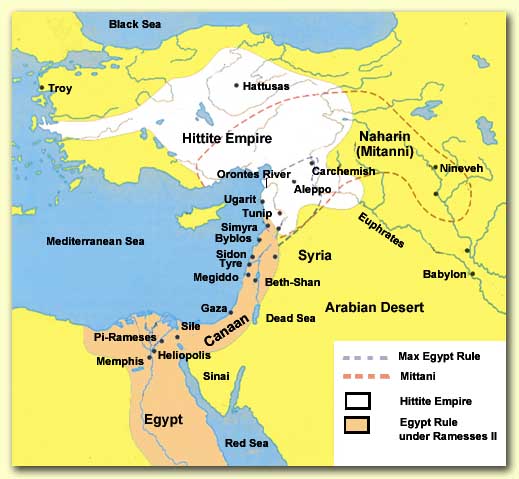
The Hittite Empire
The text begins saying
that in the olden days
Alulu was king in heaven
for nine years and then
his cup bearer Anu
vanquished him and Alulu
escaped into the dark
earth. But it was only
another nine years until
Anu's own cup bearer
betrayed him. Kumarbi is
said to have rushed him
and bit off his "knees".
Kumarbi swallowed Anu's
manhood and laughed, but
then Anu gave him a dire
premonition:
"Rejoice not over thine
inside! In thine inside I
have planted a heavy
burden. Firstly I have
impregnated thee with the
noble Storm-god. Secondly
I have impregnated thee
with the river Tigris, not
to be endured. Thirdly I
have impregnated thee with
the noble Tasmisus [The
Storm-god's servant].
Three dreadful gods have I
planted in thy belly as
seed. Thou shalt go and
end by striking the rocks
of thine own mountain with
thy head!"
Anu then went and hid
himself in heaven. The
text is fragmented here
but it seems that Kumarbi
tries to spit it back out
and some of the semen hits
Mt. Kanzuras and creates a
god inside the mountain.
Then filled with fury,
Kumarbi goes back to his
city Nippur and starts
counting the months of his
pregnancy. Anu somehow
advises the storm god
where to exit Kumarbi's
body and Teshub (the
Storm-god) responds that
the earth will give him
strength, the sky would
give valor, Anu would give
him manliness and Kumarbi
would give him wisdom. He
is warned once again what
will happen if he comes
out of Kumarbi's "tarnassas".
As Kumarbi is walking he
falls down, and like
Chronos tells his wife
Ayas that he wants to
devour his son. Ayas
probably gives him a rock
in this version too since
whatever he ate hurts his
mouth and he begins to
moan. People were brought
in to work magic on him
and to keep bringing
sacrificed meals to him.
It is said that Teshub is
born out of the "good
place" and when the birth
is reported to Anu, he
plots to use him to defeat
Kumarbi. Teshub prepares
for the battle although
the outcome is not
preserved.
The inheritance of godly
powers is a common motif
amongst tales of the gods.
The fact that Teshub is
born from both Anu and
Kumarbi is probably to
show that Teshub was born
from the best qualities of
both them. Kingship in
Heaven is found along
with the Song of
Ullikummi, which acts
as a sequel to Kingship
but may have been written
by a different author. One
perplexity about this
story is that one would
assume up to this point
that as king of the gods,
Kumarbi could easily be
identified with Enlil,
especially since his chief
city is Nippur. But in
this legend Ellil (Enlil)
makes his own appearance
and seems to denounce
Kumarbi. This may have
been an attempt of another
author to disassociate
Enlil with the villianous
role Kumarbi takes. On the
other hand, his actions do
seem to parallel Kumarbi's,
so it may just be a
misunderstanding. The text
is in particularly poor
condition, especially at
the end.
The story begins with
Kumarbi nursing an evil
plot. He takes his staff
and shoes and goes to his
city of Urkis (Kish?) and
sleeps with a great rock
ten times. The mountain
gives birth to Ullikummi,
whose name may mean
something like "Destroyer
of Kummiya". The
Good-women and
Mother-goddesses bring the
newborn to Kumarbi and
place him on his knees.
Kumarbi embraces his son
and has him dance up and
down on top of his lap and
says to his soul:
"What name [shall I give]
him? The child which the
Good-women and the
Mother-goddesses presented
me, [for the reason that
he] shot forth from her
body as a shaft, let him
go and [his] name be Ullikummi! Let him ascend
to heaven for kingship!
Let him vanquish Kummiya,
the beautiful city! Let
him attack Storm-god and
tear [him] to pieces like
a mortal! Let him tread
him under foot like an
ant! Let him crush
Tasmisus like a reed in
the brake! Let him shot
down all the gods from the
sky like birds and let him
break them to pieces like
empty pots!"
Kummiya is unidentified
but believed to be between
the Tigris and Lake Van.
Kumarbi then gave the boy
over to the Isirra deities
(handmaidens of the Fate
Goddess Isirra). The
Isirra deities take
Ullikummi away and nurse
him similar to how Zeus
was raised by the Nymphs.
The Isirra then places the
child on Ellil's knees and
Ellil says:
"Who is that child whom
the Good-women and the
Mother-goddesses reared?
No one among the great
gods will see mightier
battles. No one's vileness
equals Kumarbi's. Just as
Kumarbi raised Teshub, he
has [now raised] this
awesome diorite man as his
rival."
With these words the
handmaidens place the
diorite man on top of the
right shoulder of
Ubelluris, an Atlas-like
giant who is carrying the
world on his shoulders.
The strong waters makes
the diorite man grow and
in a month he is an acre
in height. After 15 days
he grows up out of the sea
until the sea reaches his
loincloth. Here, the text
becomes so fragmented that
it is hard to distinguish
the order of events. It
seems that the Sun-god
sees the diorite man and
informs Teshub. Teshub and
his sister Ishtar (Inanna)
climbs to the top of Mount
Hazzi (Mount Cassius) to
see it for themselves.
Teshub weeps bitterly,
asking who could ever
defeat such a monster, but
Ishtar is not convinced.
Teshub orders his servant
Tasmisu to fetch his bulls
and thunderstorms and goes
to do battle with the
diorite man. The gods
fight him but Ullikummi is
impervious to their
attacks and makes his way
to Teshub's city of
Kummiya, where the storm
god is forced to admit
defeat. Tasmisu informs
Teshub's Queen Heba of the
city's loss and that her
husband must remain in a
'lowly place' for now and
the queen almost faints
off the roof but is caught
by her attendants. Teshub
descends to the 'city'
Abzuwa (abzu) and
tries to gain the help of
Ea (Enki). Ea informs
Ellil and then goes to
talk to the Atlas-giant
Upelluri. Upelluri tells
Ea that he hadn't noticed
when heaven and earth had
been built on him, hadn't
even noticed when heaven
and earth were separated
with the great saw, but
now the diorite man was
causing his shoulder to
hurt. When Ea heard this
he got an idea. He had the
ancient storehouses opened
and brought back the saw
that had freed heaven and
earth. With this he cut
the diorite man's feet
from under him and then
urged the gods to renew
the battle. The end of the
story is lost but there's
little doubt what happens
next.
By comparing the Sumerian
Texts to Kingship in
Heaven and Theogony,
we can see the evolution
of the story as it goes
from the Sumerians to the
Hurrians to the Greeks.
For instance, neither
Sumerian, Akkadian nor
Babylonian texts ever
portray any antagonism or
sense of replacement
between An and Enlil,
although Enlil-Kumarbi's
role in the
Hurrian/Hittite epic is
that of a tyrant, which is
then inherited by Greek
version.
In both the
Hurrian/Hittite and Greek
legends, the fight takes
place at Mt. Cassius
(Hazzi), where the storm
god loses his first battle
with the monster. The
Sumerian version also
places the fight on a
mountain. This
verification of the battle
site is probably a
figurative representation
of a historic battle. A
passage in Milton's
Paradise Lost reads:
"A gulf profound as that
Serbonian bog, betwixt
Damiata and Mount Cassius
old, where armies whole
have sunk."
The story of Ninurta
fighting the Anzu bird is
a source of inspiration
for the later creation
story of the Babylonians,
who have their own storm
god Marduk fighting the
multi-headed dragon Tiamat
(Nammu) in order save the
Anunnaki and man kind.
Ninurta himself is
considered a storm god
because of his ability to
control the winds. Many
scholars believe the text
is meant to explain the
replacement of the totem
animal deity- the bird
representing the thick
storm clouds- with a more
modern anthropomorphic
warrior storm god.6
The association Tiamat has
with serpents is matched
by the Greek Typhoeus, who
has a snake's tail and
dragon heads growing from
his shoulders. The image
of a god with dragon heads
growing from the shoulders
can also be found on
Dumuzi's companion
Ningishzida. Typhaeous
himself is often
represented as having a
hundred dragon heads, as
well as his children: the
Hydra, the Chimera, and
the hell-hound Cerberus.
Dumuzi's ancestry to the
Mother Dragon Nammu
mentioned often in
Sumerian texts. The
slaying of the dragon may
have represented the
triumph of the
warrior-like storm god
over the fleeing
shepherd/fisherman god as
the dominant deity over
the seasons. Although the
storm god took many
different personal names
throughout different
cultures, some of them
reflecting different
identities amongst the
original Sumerian
pantheon, the vast
majority of Mesopotamia
knew these rain-bringing
cloud-riders as Ba'als.
| |
Sumerian |
Babylonian |
Canaanite |
Hurrian |
Greek |
| Freshwater |
abzu |
Apsu |
|
|
abussos |
| Sky arch |
|
Anshar |
|
Alulu |
|
| Sky god |
An |
Anu |
|
Anu |
Uranus |
| Air god |
Enlil |
Ellil |
El the Bull |
Kumarbi |
Kronos |
| Storm god |
Ninurta |
Marduk |
Hadad |
Teshub |
Zeus |
| Nemesis |
Anzu |
Tiamat |
Yahm |
Ullikummi |
Typhoeus |
<<Chapter 5
Chapter 7>>
|
*******
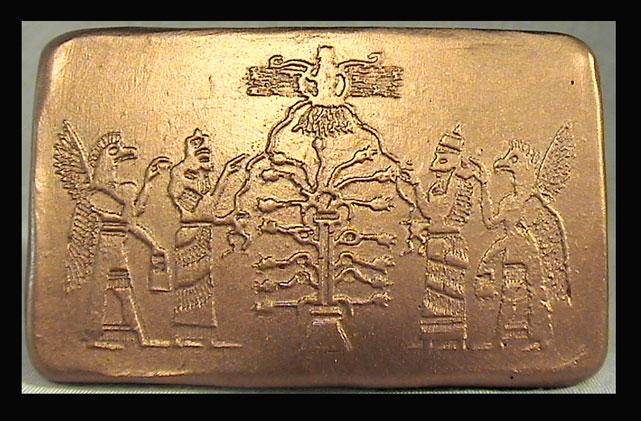
Stone cast tablet, 85 x 50
mm (approx 3.5 x 2"),
antique gold finish, with
museum display stand &
parchment description
Reproduction of a British
Museum cylinder seal design,
from the seal of
Mushezib-Ninurta,
viceroy of the ancient city
of Shadikanni
in eastern Syria, 883 BC,
during which time the city
was an Assyrian vassal.
The
owner of this seal can
be identified from the
cuneiform inscription
which translates:
'Seal of Mushezib-Ninurta,
governor, son of
Ninurta-eresh,
ditto, son of
Samanuha-shar-ilani,
ditto.'
Samanuha-shar-ilani was
ruler of Shadikanni
(Arban in eastern
Syria), in 883 BC, and
an Assyrian vassal -
subject to the firm
control of Assyria,
and enjoying the wealth
and security that such
political domination
provided.
During this period, seal
designs were often cut
on hard stones using
cutting-wheels and
drills.
The image is similar to
two wall reliefs from
the throne room of King
Ashurnasirpal II
(reigned 883-859 BC) at
Nimrud. The king, shown
in mirror image, is
protected by
guardian genii
sprinkling holy water
from a bucket using what
may be a fir cone or
sponge.
A stylized tree stands
in the centre,
symbolizing nature and
the land of Assyria.
Above is a god in the
winged disc.
Found by H.C. Rawlinson
and acquired by The
British Museum around
1852
D. Collon, First
impressions: cylinder
seals in the Ancient
Near East (London, The
British Museum Press,
1987), pp. 76-7, fig.
341
A.H. Layard, Discoveries
in the ruins of Nineveh
and Babylon (London, J.
Murray, 1853), p. 603
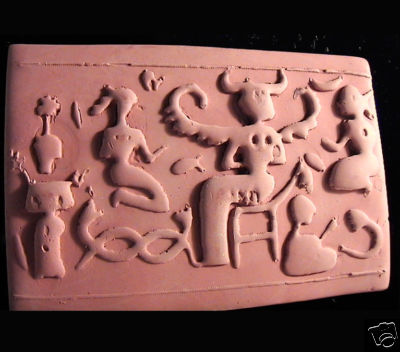
TABLET
Horned Ishtar
2100
BC reproduction
Stone cast terracotta
relief tablet, 70 x 45 mm (approx 2 x 2.5”), on 110 mm (4.25") black
acrylic mount, with museum display stand & description
Reproduction of an archaic
seal impression tablet from Tepe Yahya in Iran, dated to the 3rd
Millennium BC … an area notable as the source of refined chlorite bowls
for the Sumerian markets.
Following the fall of the Akkadian Empire, during the last Sumerian
dynasty around the 21st century BC, a renaissance of Sumerian culture
across Mesopotamia saw the reappearance of cylinder seals which harken
back to Early Dynastic prototypes.
Designs of this type, depicting the goddess Ishtar with characteristic
crescent horns and her ritual attendants, are attributed to the Gutian
Invaders. The hand carved silhouette style appeared amongst traders after
the destruction of the famous seal-making workshops of the Akkadian
Empire.
MYTHIC DESCRIPTION
Flanked by two hand-maidens, the tablet depicts a stark silhouette of the
celestial goddess Ishtar. Her wings
indicate her heavenly origins. She is enthroned to symbolize her supremacy
of the sky and surrounded by a medley of images, which include the ancient
flood symbols of swimming fish. Like the
Hathor Cow of Egypt, she is portrayed with the head of a bull,
recalling the mythic tale when she dispatched the elemental forces of the
“Bull of Heaven” upon a hapless earth.
The stricken and
decapitated earth god Ea-Enki,
grasps a branch, symbolic of the Tree of
Life. A large star connected to his head shows his subjection to
stellar influences. At his feet, twin serpents wrestle to form the double
loop of the continuous cycles of nature. On the opposite side, a snake
charmer summons the demon-elemental forces of the Genii which assaulted
the world during the mythic War of the Gods.
|
|
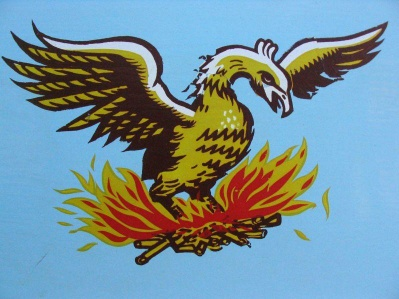
THE PHOENIX
The phoenix (Ancient
Greek: Φοῖνιξ, phoínix) is a
mythical sacred
firebird which originated in the ancient mythologies mentioned
in the
Greek Mythology, and later the
Phoenician and the
Egyptian.
Appearance and
Abilities
A phoenix is a mythical bird with a colourful
plumage and a tail of gold and scarlet (or purple and blue,
according to some sources [1]). It has a 500 to 1,000 year
life-cycle, near the end of which it builds itself a nest of
myrrh
twigs that then ignites; both nest and bird burn fiercely and are
reduced to ashes, from which a new, young phoenix or phoenix egg
arises, reborn anew to live again. The new phoenix is destined to
live as long as its old self. In some stories, the new phoenix
embalms the ashes of its old self in an egg made of myrrh and
deposits it in the Egyptian city of Heliopolis (sun city in
Greek). The bird was also said to regenerate when hurt or wounded
by a foe, thus being immortal and invincible — it is also said
that it can heal a person with a tear from its eyes and make them
temporarily immune to death. The phoenix is a symbol of fire and
divinity.[2]
History
Flavius Philostratus (c.
AD 170), who wrote the biography Life of Apollonius of Tyana,
refers to the phoenix as a bird living in India, but sometimes
migrating to Egypt every five hundred years. His account is
clearly inspired by
Garuda, the bird of the Hindu god
Vishnu. He considered the bird as an emanation of sunlight,
being in appearance and size much like an eagle. His contemporary
Lactantius is probably the author who wrote the longest poem
on the famous bird. Although descriptions (and life-span) vary,
the Egyptian phoenix (Bennu
bird) became popular in early
Catholic art, literature and
Catholic symbolism, as a symbol of Christ representing his
resurrection,
immortality, and
life-after-death. One of the Early Catholic Church Fathers,
Clement, related the following regarding the Phoenix in chapter 25
of The First Epistle of Clement:
Let us consider that wonderful sign [of the
resurrection] which takes place in Eastern lands, that is, in
Arabia and the countries round about. There is a certain bird
which is called a phoenix. This is the only one of its kind, and
lives five hundred years. And when the time of its dissolution
draws near that it must die, it builds itself a nest of
frankincense, and myrrh, and other spices, into which, when the
time is fulfilled, it enters and dies. But as the flesh decays a
certain kind of worm is produced, which, being nourished by the
juices of the dead bird, brings forth feathers. Then, when it
has acquired strength, it takes up that nest in which are the
bones of its parent, and bearing these it passes from the land
of Arabia into Egypt, to the city called Heliopolis. And, in
open day, flying in the sight of all men, it places them on the
altar of the sun, and having done this, hastens back to its
former abode. The priests then inspect the registers of the
dates, and find that it has returned exactly as the five
hundredth year was completed.
Michael W. Holmes points out that early
Christian writers justified their use of this myth because the
word appears in Psalm 92:12 [LXX Psalm 91:13], but in that passage
it actually refers to a palm tree, not a mythological bird.[1]
However, it was the flourishing of Christian Hebraist
interpretations of Job 29:18 that brought the Joban phoenix to
life for Christian readers of the seventeenth century. At the
heart of these interpretations is the proliferation of richly
complementary meanings that turn upon three translations of the
word chol (חול) — as phoenix, palm tree, or sand — in Job 29:18.
[2]
Originally, the phoenix was identified by the
Egyptians as a
stork or
heron-like bird called a
benu,
known from the
Book of the Dead and other Egyptian texts as one of the
sacred symbols of worship at Heliopolis, closely associated with
the rising
sun and the
Egyptian
sun-god
Ra.
The
Greeks identified it with their own word phoenix φοίνιξ,
meaning the color purple-red or
crimson (cf.
Phoenicia). They and the
Romans subsequently pictured the bird more like a
peacock or an
eagle.
According to the
Greeks the phoenix lived in Phoenicia next to a well. At dawn,
it bathed in the water of the well, and the Greek sun-god
Helios stopped his chariot (the sun) in order to listen to its
song. Featured in the painting Heracles Strangles Snakes
(House of the Vettii, Pompeii Italy) as
Zeus,
the king of the gods.
One inspiration that has been suggested for
the Egyptian phoenix is the
flamingo of
East Africa. This bright pink or white bird nests on
salt
flats that are too hot for its
eggs or chicks to survive; it builds a mound several inches
tall and large enough to support its egg, which it lays in that
marginally cooler location. The convection currents around these
mounds resembles the
turbulence of a
flame.
In zoology, flamingos are part of the family
Phoenicopteridae, from the generic name Phoenicopterus
or "phoenix-winged."
"Phoenix" is also the English-language name
given to the most important bird in Chinese mythology, the
fenghuang, with its own set of characteristics and symbolic
meanings.
Related usage
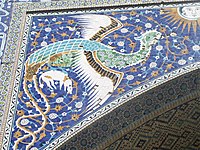
Phoenix on the portal of Nadir Divan-Beghi
madrasah (part of
Lyab-i Hauz complex)
In
Persian mythology, Si'morgh, (Persian:
سيمرغ,
Middle Persian: senmurv) was a winged, bird-like creature that
was very large and extremely ancient. The Simurgh appears in many
Iranian literary classics such as
Farid ud-Din Attar's
Conference of the Birds as instructor and birds leader,
and in
Ferdowsi's epic
Shahnameh (The Book of Kings); Phoenix raised up and
cherished Zaal or
Zal,
father of
Rostam.
The phoenix the central figure in
Lebanese ancient and modern cultures, as Lebanese are
descendants of the Phoenicians and often claim themselves sons of
the Phoenix.[citation
needed] Lebanon, and Beirut particularly, is often
depicted symbolically as a phoenix bird having been destroyed and
rebuilt 7 times during its long history.
In
China,
Fenghuang ("鳳凰") is a mythical bird superficially similar to
the phoenix. It is the second most-respected legendary creature
(second to the
dragon), largely used to represent the empress and females.
The phoenix is the leader of birds.
In
Japan,
the phoenix is called hō-ō(kanji:"鳳凰") or fushichō
(不死鳥?);
"Immortal Bird".
In
Russian folklore, the phoenix appears as the
Zhar-Ptitsa (Жар-Птица), or firebird, subject of the famous
1910
ballet score by
Igor Stravinsky. The phoenix was featured in the flags of
Alexander Ypsilantis and of many other captains during the
Greek Revolution, symbolizing Greece's rebirth, and was chosen
by
John Capodistria (1828-1832). In addition, the first modern
Greek currency bore the name of
phoenix. Despite being replaced by a royal Coat of Arms,
it remained a popular symbol, and was used again in the 1930s by
the
Second Hellenic Republic. However, its use by the
military junta of 1967-1974 made it extremely unpopular, and
it has almost disappeared from use after 1974, with the notable
exception of the Greek
Order of the Phoenix). It was introduced by Johann Bayer in
1603.
See also
- The Phoenix has been in a numerous times
the main motive for collectors’ coins and medals, one of the
most recent one is the famous Belgian 10 euro silver coin
60 years of peace. The obverse depicts the Phoenix as a
representation of a new Europe, post 1945.
-
Főnix Hall, an arena in
Debrecen,
Hungary, which was named after the Phoenix.
-
Fenghuang, commonly
referred to as the Chinese phoenix.
-
Firebird (Russian folklore),
an equivalent of phoenix in Russian mythology.
-
Bennu, an Egyptian
correspondence to the phoenix.
-
Angha, a
Huma,
Simurgh, Persian phoenixes.
-
Adarna, a Philippine
version of the phoenix
-
Avalerion, an Indian
magic bird that drowns itself once it has laid its eggs.
-
Garuda, an Indian
version of the phoenix.
References
- R. Van den Broek, The Myth of the
Phoenix - According to Classical and Early Christian Traditions,
E.J.Brill, Leiden, 1972.
- Silvia Fabrizio-Costa (ed.), La Fenice :
mito e segno (simposio dell’università di Caen), Peter Lang,
Bern, 2001.
ISBN 3-906767-89-2
- Françoise Lecocq, « Les sources
égyptiennes du mythe du phénix », L’Egypte à Rome (simposio
dell’università di Caen), éd. F. Lecocq, Cahiers de la Maison de
la Recherche en Sciences Humaines, n° 41, Caen, 2005. ISSN
1250-6419, reed. 2008 (p211-266.)
- Francesco Zambon, Alessandro Grossato,
Il mito della fenice in Oriente e in Occidente, Venezia,
Marsilio Editori, 2004.
ISBN 88-317-8614-8
External links
|
Rise of the Phoenix
There are Chinese, Japanese, Russian, Egyptian, and Native American
counterparts of the Phoenix.
They are -Huang, Ho-oo, Firebird, Benu, and Yel respectively).
All of these birds are identified with the sun.
A mythical bird that never dies, the phoenix flies far ahead to the
front, always scanning the landscape and distant space. It represents
our capacity for vision, for collecting sensory information about our
environment and the events unfolding within it. The phoenix, with its
great beauty, creates intense excitement and deathless inspiration.
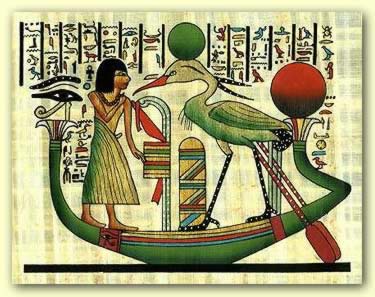
Related to the verb weben (wbn), meaning
"to rise", "rise in brilliance" or "shine" as well as ben-ben,
the up thrust sacred stone of
Heliopolis, benu (bennu) describes a bird that was an
important avian deity. Originally of solar associations, the
Benu bird came to be connected with three important gods
consisting of
Atum,
Re and
Osiris.
As an aspect of Atum, the Benu bird was
said to have flown over the waters of
Nun
before the original creation. According to this tradition, the
bird came to rest on a rock from which its cry broke the
primeval silence and this determined what was and what was not
to be in the unfolding
creation.
The Benu, according to ancient Egyptian
mythology, was also believed to be the
ba
of Re, and by Egypt's
Late
Period, the hieroglyphic sign depicting the bird was used to
write the name of this sun god. During the
Middle Kingdom, it was said that the Benu of
Re was
the means by which
Atum
came into being in the Primeval water.
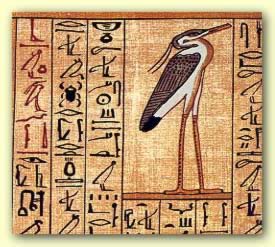 Like
the sun god, the Benu's own birth is attributed to self
generation. A mythological papyri of the
21st Dynasty
provides a vignette of a heart-amulet
and scarab beetle near to which stand the Benu, which is
described as "the one who came into being by himself". It was
believed to constantly rise renewed just like the sun, and was
called the "lord of jubilees". The Benu Bird was said to each
morning appear under the form of the rising sun, and was
supposed to shine upon the world from the top of the famous persea tree in
Heliopolis wherein he renewed himself. Like
the sun god, the Benu's own birth is attributed to self
generation. A mythological papyri of the
21st Dynasty
provides a vignette of a heart-amulet
and scarab beetle near to which stand the Benu, which is
described as "the one who came into being by himself". It was
believed to constantly rise renewed just like the sun, and was
called the "lord of jubilees". The Benu Bird was said to each
morning appear under the form of the rising sun, and was
supposed to shine upon the world from the top of the famous persea tree in
Heliopolis wherein he renewed himself.
This most likely led to the concept of its
long life, later identifying it with the Greek phoenix which
also renewed itself from a fiery death like the sun rising at
dawn. In fact, it may have been the prototype for the phoenix,
and there may well be an etymological connection between the two
birds' names, though certainly there are distinct differences
between myths surrounding them.
The bird was primarily associated with
Atum and
Re, but
inevitably, its connection with rebirth came to associate it
also with
Osiris. In quoting from the
Book
of the Dead, Wallis Budge quotes a passage that reads, "I go
in like the Hawk, and I come forth like the Bennu, the Morning
Star (i.e., the planet Venus) of Ra; I am the Bennu which is in
Heliopolis" and he goes on to say that the scholion on this
passage expressly informs us that the Benu is Osiris. In
essence, the Benu was considered a manifestation of the
resurrected Osiris.
Herodotus tells us that the bird lived for
500 years before building a nest of aromatic boughs and spices
which it then set ablaze and was consumed within the inferno.
From the conflagration a new Benu bird arose who, after
embalming its father's ashes, flew with them to
Heliopolis where it deposited the ashes on the altar of the
temple of Re. However, this tale told by Herodotus has no
foundation in actual
pharaonic mythology, where the bird never seems to
permanently die. There were, in fact, a number of classical
interpretations of the Benu bird which resulted in a
misunderstanding of the Egyptian myth, perhaps because of the
association with the Egyptian bird and the Greek phoenix.
Iconography
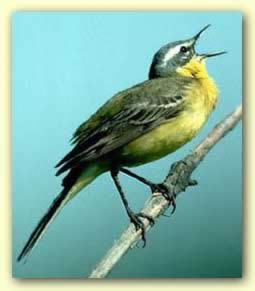 At
Heliopolis where the Benu bird first served as a symbol of
solar deities, its iconography was probably fashioned from the
yellow wagtail (Motacilla flava) which, according to the
Pyramid Texts, represented
Atum.
However, by the
New
Kingdom, the bird was usually depicted as a gray heron (ardea
cinera). At that point in Egyptian mythology, it was usually
represented with long legs and beak, and a two-feather crest
growing form the back of its head. Typically, the bird
surmounted a stylized ben-ben stone as a symbol of the great
solar god, but its association with
Osiris
meant that it was also sometimes represented in the sacred
willow of that god. Sometimes, it was also depicted wearing the
Atef
Crown in its aspect as Osiris. In at least, one the
sarcophagus of the
Divine Adoratrice of Amun, Ankhnesneferibre, now in the
British Museum, the Benu is imagined as perched on a sacred
willow tree in the temple. However, the Benu could also be
depicted in a hybrid form with the head of a man. Classically,
the Benu bird is described as being as large as an eagle, with
red and gold (solar or flame-colored) plumage. At
Heliopolis where the Benu bird first served as a symbol of
solar deities, its iconography was probably fashioned from the
yellow wagtail (Motacilla flava) which, according to the
Pyramid Texts, represented
Atum.
However, by the
New
Kingdom, the bird was usually depicted as a gray heron (ardea
cinera). At that point in Egyptian mythology, it was usually
represented with long legs and beak, and a two-feather crest
growing form the back of its head. Typically, the bird
surmounted a stylized ben-ben stone as a symbol of the great
solar god, but its association with
Osiris
meant that it was also sometimes represented in the sacred
willow of that god. Sometimes, it was also depicted wearing the
Atef
Crown in its aspect as Osiris. In at least, one the
sarcophagus of the
Divine Adoratrice of Amun, Ankhnesneferibre, now in the
British Museum, the Benu is imagined as perched on a sacred
willow tree in the temple. However, the Benu could also be
depicted in a hybrid form with the head of a man. Classically,
the Benu bird is described as being as large as an eagle, with
red and gold (solar or flame-colored) plumage.
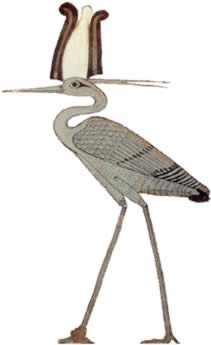 The
bird was frequently depicted in the vignettes of the netherworld
books as well as on heart
amulets
and other objects, particularly those of a funerary nature.
When carved on the back of a heart-scarab and buried with the
dead, it is a symbol of anticipated rebirth in the netherworld
and ensures that the heart does not fail in the examination of
past deeds in the Hall of the Two Truths (judgment
of the dead). In the
Book
of the Dead there are formulae to transform the deceased
into the Great Benu. Here, the deceased says, "I am the Benu,
the soul of Ra, and the guide of the gods in the Duat." In
another verse, he says, "I am pure. My purity is the purity of
the Great Benu which is in the city of Suten-henen." The
bird was frequently depicted in the vignettes of the netherworld
books as well as on heart
amulets
and other objects, particularly those of a funerary nature.
When carved on the back of a heart-scarab and buried with the
dead, it is a symbol of anticipated rebirth in the netherworld
and ensures that the heart does not fail in the examination of
past deeds in the Hall of the Two Truths (judgment
of the dead). In the
Book
of the Dead there are formulae to transform the deceased
into the Great Benu. Here, the deceased says, "I am the Benu,
the soul of Ra, and the guide of the gods in the Duat." In
another verse, he says, "I am pure. My purity is the purity of
the Great Benu which is in the city of Suten-henen."
Worship
Surprisingly little is known of the formal
veneration of this important aspect of ancient Egyptian
mythology. However, it is highly probable that it formed the
basis for an important role in the cults near
Heliopolis, where the cult was first established and
probably most important. Wallis Budge tells us that "the
sanctuary of the Bennu was the sanctuary of Ra and
Osiris,
and was called Het Benben, i.e., the 'House of the Obelisk'..."
However, almost nothing else is known about the worship of the
most ancient of Egyptian icons.
FROM:
http://www.touregypt.net/featurestories/benu.htm
The ancient Egyptians linked the myth of the phoenix with the longings
for immortality that were so strong in their civilization, and from there
its symbolism spread around the Mediterranean world of late antiquity.
The Bennu bird was usually depicted as a heron. Archaeologists have found
the remains of a much larger heron that lived in the Persian Gulf area
5,000 years ago. The Egyptians may have seen this large bird only as an
extremely rare visitor or possibly heard tales of it from travelers who
had trading expeditions to the Arabian Seas.
It had a two long feathers on the crest of it's head and was often crowned
with the Atef crown of Osiris (the White Crown with two ostrich plumes on
either side) or with the disk of the sun.
This Egyptian phoenix was also associated with the inundation of the Nile
and of the creation. Standing alone on isolated rocks of islands of high
ground during the floods the heron represented the first life to appear on
the primeval mound which rose from the watery chaos at the first creation.
This mound was called the ben-ben. It was the Bennu bird's cry at the creation
of the world that marked the beginning of time. The bennu thus was the got of
time and its divisions -- hours, day, night, weeks and years.
The Bennu was considered a manifestation of the resurrected Osiris and the
bird was often shown perched in his sacred willow tree.
Perhaps the most well known, the Arabian phoenix was a fabulous mythical bird,
said to be as large as an eagle, with brilliant scarlet and gold plumage and a
melodious cry. Making it's home near a cool well, the Phoenix would appear at
dawn every morning to sing a song so enchanting that even the great sun god
Apollo would stop to listen.
It was said that only one phoenix existed at any one time, and it is very
long-lived with a life span of 500 years, 540 years, 1000 years, 1461 years
or even 12,994 years (according to various accounts). As the end of its life
approached, the phoenix would build a pyre nest of aromatic branches and
spices such as myrrh, sets it on fire, and is consumed in the flames. After
three days the birth -- or as some legends say a rebirth -- the phoenix arises
from the ashes. According to some sources, the phoenix arose from the midst of
the flames.
The young phoenix gathers the ashes of its predecessor into an egg of myrrh and
takes it to Heliopolis, the city of the sun, to deposit it on the alter of the
sun god.
A symbolic representation of the Death and rebirth of the sun. It is also
described as being either eagle like or heron like. It lives on dew, killing
nothing and crushing nothing that it touches. Generally considered the king of
birds. It has alternatively been called the bird of the sun, of Assyria, of
Arabia, of the Ganges, the long-lived bird and the Egyptian bird. The earliest
reference to the Phoenix was made by Hesiod in the 8th century B.C., but the most
detailed account is by Herodotus of Halicarnassus, the famous Greek historian in
5th century B.C.
In Chinese mythology, the phoenix is the symbol of high virtue and grace, of
power and prosperity. It represents the union of yin and yang. It was thought
to be a gentle creature, alighting so gently that it crushed nothing, and eating
only dewdrops.
It symbolized the Empress usually in a pairing with a dragon (the dragon
representing the Emperor), and only Empress could wear the phoenix symbol The
phoenix represented power sent from the heavens to the Empress.
If a phoenix was used to decorate a house it symbolized that loyalty and honesty
was in the people that lived there. Jewelry with the phoenix design showed that
the wearer was a person of high moral values, and so the phoenix could only be
worn by people of great importance. The Chinese phoenix was thought to have the
beak of a cock, the face of a swallow, the neck of a snake, the breast of a goose,
the back of a tortoise, hindquarters of a stag and the tail of a fish.
A common depiction of the Feng Huang was of it attacking snakes with its talons
and its wings spread. In fact images of the phoenix have appeared throughout China
for well over 7000 years. Often in jade and originally on good-luck totems.
Although during the Han period (2200 years ago) the phoenix was used as a symbol
depicting the direction south shown as a male and female phoenix facing each other.
It carried two scrolls in its bill, and its song included the five whole notes of
the Chinese scale (I don't exactly know how it could sing with its mouth full).
Its feathers were of the five fundamental colors: black, white, red, green, and
yellow and was said to represent the Confucian virtues of loyalty, honesty,
decorum and justice. Depictions of the phoenix were placed on tomes and graves.
THE JAPANESE HOU OU - Ho-Oo BIRD
The Ho-Oo has been adopted as a symbol of the royal family, particularly the empress.
It is supposed to represent the sun, justice, fidelity and obedience. It was used in
a wide variety of items including mirrors, lacquerware, textiles and chests.
PHOENIX
Origin: China
Feng Huang (Chinese)
Hou-ou (Japanese)
Feng (Hou) represents male phoenix, yang, solar
Huang (Ou) represents female phoenix, yin, lunar
Often depicted together with the
Dragon,
either as mortal enemies or as blissful lovers.
Considered equivalent to
Red Bird | Big Bird (Suzaku)
One of the guardians of the
Four Directions (Shishin)
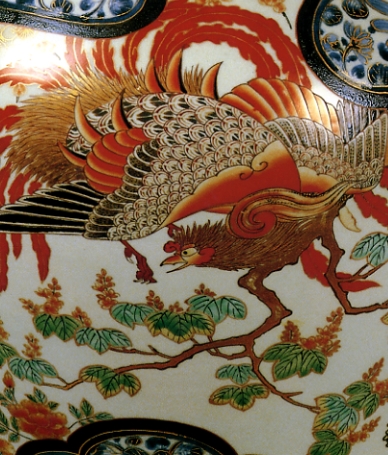
Phoenix, Image from Imari Porcelain ware
Photo courtesy Nihon Toji Taikei, Vol. 19 (Imari Ware)
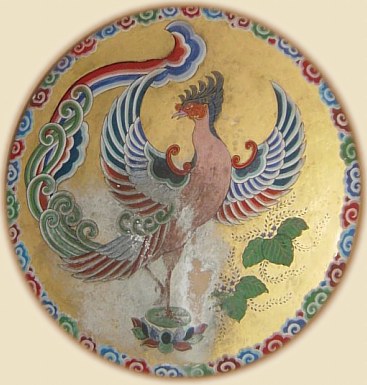
Phoenix Drum, Engaku-ji Temple Bell Tower, Kita-Kamakura
In
Japan, as earlier in China, the mythical Phoenix was adopted as a symbol
of the imperial household, particularily the empress. This mythical bird
represents fire, the sun, justice, obedience, and fidelity.
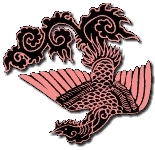
According to legend (mostly from China), the Ho-oo appears very rarely,
and only to mark the beginning of a new era -- the birth of a virtuous
ruler, for example. In other traditions, the Ho-oo appears only in
peaceful and prosperous times (nesting, it is said, in paulownia trees),
and hides itself when there is trouble. As the herald of a new age, the
Ho-Oo decends from heaven to earth to do good deeds, and then it returns
to its celestial abode to await a new era. It is both a symbol of peace
(when it appears) and a symbol of disharmony (when it disappears). In
China, early artifacts show the Phoenix (female) as intimately associated
with the Dragon (male) -- the two are portrayed either as mortal enemies
or as blissful lovers. When shown together, the two symbolize both
conflict and wedded bliss, and are a common design motif even today in
many parts of Asia (see below).
鳳
= Feng, Male Phoenix
凰
= Huang, Female Phoenix
The Chinese compound term Feng Huang means Phoenix. The Feng Huang was
believed to control the five tones of traditional Chinese music and to
represent the
Confucian virtues of loyalty, honesty, decorum and justice. Its
image first appears on Shang artifacts of China's Western Zhou Period
(11th century BC to 771 BC).
The symbolism of the Chinese Phoenix (Feng Huang) is strikingly similar to
the symbolism of the mythological Red Bird (Zhuque
朱雀), also of
Chinese lore.
In Japan, the Red Bird is
pronounced Suzaku (same Chinese characters). I believe the Red Bird is the
same creature as the Phoenix, although I may be wrong. The Red Bird is one
of four legendary Chinese creatures guarding the four cosmic directions
(Red Bird-S, Dragon-E, Tortoise-N, and the Tiger-W). The four appear
during China's Warring States period (476 BC - 221 BC), and were
frequently painted on the walls of early Chinese and Korean tombs to ward
off evil spirits. Please visit the
Shishin (four celestial guardians) page for more on these four
creatures and their manifestations in Japan. Please click here for more on
Suzaku. For more details on Phoenix lore in China, please
click here.
The Asian Phoenix should not be confused with the Phoenix found in Egypt
and Greece -- that is a bird of completely different feathers and
traditions. The Arabian-Western Phoenix, if you recall, is a solidary
creature -- only one of its kind. When it dies, it dies in flames, and
from the ashes is born the next phoenix.
Click here for background on the Egyptian and
Greek phoenix.
Hou-ou |
鳳凰
| ほうおう
HISTORICAL NOTES ON THE PHOENIX IN JAPAN
Below courtesy www.aisf.or.jp/~jaanus/deta/h/houou2.htm
A mythical Chinese bird, thought to have been introduced to Japan in the
Asuka period (mid 6th to mid 7th century AD). The phoenix has a bird's
beak, a swallow's jaw, and a snake's neck; the front half of its body is
thought to resemble a giraffe, the back half a deer. Its back resembles a
tortoise, and its tail is like a fish. It is often shown in a paulownia
tree (Chinese parasol tree, aogiri
梧桐), with bamboo
in the background, or surrounded by Chinese arabesque foliage karakusa
唐草. It became a
popular decorative motif in the Nara period (late 7-8c), and was used on a
wide variety of items including textiles, mirrors, chests, and lacquerware.
Outstanding early examples of the phoenix designs can be seen on the
ceiling of Houryuuji Kondou Nishi-no-ma
法隆寺金堂西の間 (late
7c). Houou depicted on the back of mirrors were popular in the Heian
period (9-12c). Some of these used a Chinese style, but others Japanized
the houou motif, replacing arabesque foliage with Japanese wild grasses,
and changing the bird to resemble a blue magpie, onagadori
尾長鳥, or a crane,
tsuru 鶴. A famous
pair of houou statues, made of copper and measuring 1 metre in height, can
be seen on the roof of
Byoudouin Hououdo (photo here)
平等院鳳凰堂 , Kyoto
(10c). Throughout the 13-19c the houou remained a popular design,
particularly on gold and silver lacquered boxes (see makie
蒔絵) and for noh
能 costumes. The
original Chinese background of paulownia and bamboo was gradually replaced
by combinations of peonies, cherry blossoms, crysanthemums, and seasonal
Japanese wild flowers. The phoenix appears on three crests, monshou 紋章,
known as hououmaru 鳳凰円,
lit. phoenix circle, tachi houou
立ち鳳凰 lit. standing
phoenix, and tobi houou
飛び鳳凰 lit. flying phoenix. <end quote from
JAANUS>
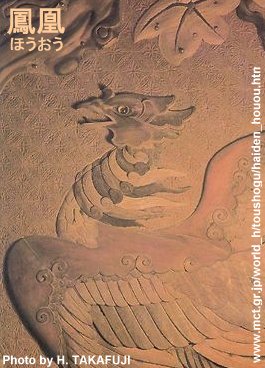
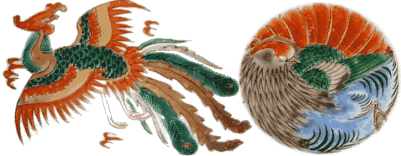
Above: Design on Edo-Period
bowl
(at the online store of blueandwhiteamerica.com)
The phoenix is typically shown with spread wings,
in the act of attacking "naga" with its strong
claws.
Skt. "NAGA" means all serpentines, snakes, and
dragons.
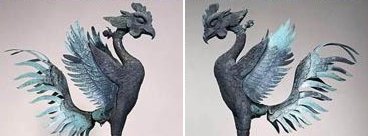
Above & Below
Heian Era, 11c, Atop
Amida Hall, Byodo-in,
Kyoto
From early times (by at least China's Han Period),
the Hou-ou was depicted as a male-female pair
facing each other.
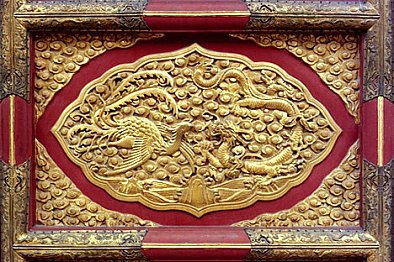
In China, the phoenix is
ofter paired with the dragon
as well -- the pair represent both conflict and
wedded bliss.
Above Photo: Hall of Heavenly and Terrestrial Union
(China)
Ornamental door design of Phoenix (Empress) and
Dragon (Emperor)
Courtesy www.kiku.com/electric_samurai/virtual_china/beijing.html
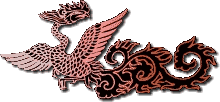 CHINESE
LORE CHINESE
LORE
tina.garnet.nu/eiko/
misc/eidolons2.htm
Feng, the Chinese phoenix, had the head of a
pheasant, the tail of a peacock, the Five Cardinal
Virtues inscribed on its body, and the most
enchanting song of any bird. Feng was associated
with the primordial forces of the heavens and was
also the bringer of good fortunes, and visions of
the phoenix god were were omens of great luck in the
near future. Long (Dragon, East, Water) and Feng
(Phoenix, South, Fire) are most often depicted as
enemies because of their opposing elements (water
and fire). Several Chinese folktales center around
the clash between the phoenix and the dragon.
However, they're also depicted as partners. Long is
the male counterpart to the female Feng, and
together they can symbolize both conflict and wedded
bliss.
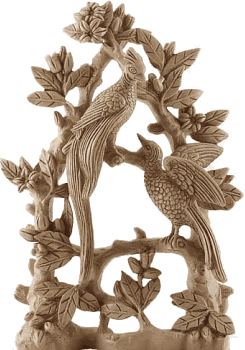 South
- the Red Bird South
- the Red Bird
"Phoenix" is used as a translation for Feng, or Feng
Huang, the sacred bird of Chinese mythology. It has
many miraculous attributes, but not
self-rejuvenation, and does not posess the Arabian
phoenix's propensity for self-immolation. It is
usually portrayed as a beautiful bird, virtually
identical to an ornamental pheasant. Few
illustrations match its verbal description, as it is
said to have the front of a swan, the hinder parts
of a unicorn, the throat of a swallow, the bill of a
chicken, the neck of a snake, the stripes of a
dragon, and the arched back of a tortoise.
Its plumage is of the five mystical colours - black,
white, red, green and yellow, and it has twelve tail
feathers, execept in years when there is an extra
month, when there are thirteen. It feeds on bamboo
seeds, lives in the branches of the dryandera tree,
and drinks from fountains of fresh water.
It is one of the four emblems of royalty, usually
associated with the Empress. The expression "Dragon
and Phoenix" signifies wedded bliss. In many
respects its symbolism has been confused and merged
with that of the Red Bird, one of the four Celestial
Emblems (Walters)."
http://www.sempai.org/~felicia/myth.html
Above exerpts from Derek Walters "An Encyclopedia of
Myth and Legend: Chinese Mythology" and Donald A.
Mackenzie "Myths of China and Japan."
Unconfirmed Research
The Asian phoenix is said to descend from the clouds
only when a virtuous ruler is born. It then alights
only on the paulownia tree (though it feeds on
bamboo seeds). The paulownia is a real tree that
bears fragrant purple flowers, often depicted as
white.
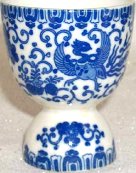 PHOENIX
HISTORY, CHINA PHOENIX
HISTORY, CHINA
http://www.fenice.com/phoenix.html
If we look at the Shang ritual cups and bronze
decorations of the Western Zou period (around 3,000
years old) we find the images of five animals often
repeated: the lion, the fish, the deer, the dragon
and the phoenix.
The lion and the fish have origins in Buddhist
icons, while the other three are often found
together, such as on the inside of the coffin of the
wife of the Marquis of Dai (2,200 years old). The
four animals dragon, tiger, unicorn (or deer) and
phoenix are called "si ling" in Chinese, and with
the passage of time other animals such as the snake
and the turtle were added to this group of animals
to be worshipped.
Right from the earliest representations the phoenix
has been shown with spread wings, often in the act
of attacking snakes with its strong claws. During
the Han period, 2,200 years ago, the Phoenix was
used as a symbol to indicate the direction south,
and was often shown in a pair of facing male and
female birds. It may also be found paired with the
dragon, in which case the dragon represents the
Emperor and the phoenix the Empress.
An interesting difference between the way the dragon
and the phoenix are shown in decorations is that the
dragon is used to fill all the space available on a
vase for example, while the phoenix is used to fill
specific space in the decoration such as around
trees, rocks, and flowers.
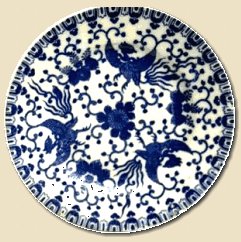 The
symbol of the Fenice has been used on objects in
China, often in jade, for over 7,000 years,
originally on good-luck totems, and then, from
around 2,000 years ago to represent power sent from
the heavens to the Empress. The
symbol of the Fenice has been used on objects in
China, often in jade, for over 7,000 years,
originally on good-luck totems, and then, from
around 2,000 years ago to represent power sent from
the heavens to the Empress.
A phoenix used to decorate a house showed loyalty
and honesty in the people who lived there. The
phoenix was believed to control the 5 tones of
Chinese music and to represent the
Confucian virtues of
loyalty, honesty, decorum and justice.
Considering the importance of this mythical bird, it
was inevitable that it would also be used to
decorate tombs and graves. The right to wear
jewellery showing the phoenix was reserved for
important people, and showed that the wearer was a
person of high moral values.
FROM:
http://www.onmarkproductions.com/html/ho-oo-phoenix.shtml
|
|
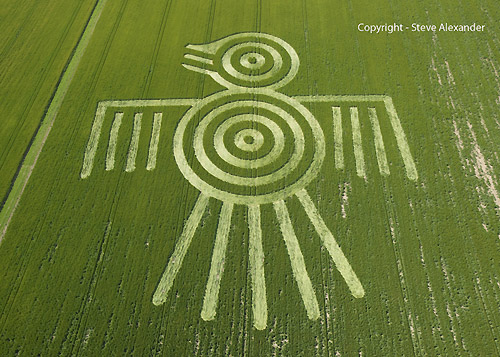
THIS CROP CIRCLE APPEARED ON 6-14-09
AT BARBURY CASTLE, ENGLAND
THIS IS THE THUNDERBIRD
AND AMERICAN INDIAN SYMBOL

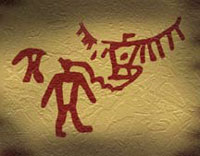
American
Indian Pictograph of a thunderbird
connected to a human by a speech line
from Wisconsin's Roche-a-Cri State Park.
Editors note: This is my own experience:
8-17-00 - DREAM - I was watching a book being created about the
people on the Survivor television show. Pictures and captions were placed
on the pages which were white. Towards the end, someone asked the
question as to why this book was being created and then the pages turned
from white to grey with overtones of pink and green.
***
8-17-00 - VISION - I was so tired I lay back down and I started to
see the Survivor page again and I heard a voice say, "The 1995 Thunderbird
is important" Then someone said, "Don't you like Indians?" then I heard
the name Allan Bronson.

In approximately 2003, I was standing in my backyard, and I saw
movement up in the sky out of the corner of my eye. I looked upward and
coming out of a large cloud was something that was black. It was
silent as it moved and I was trying to figure out if it was a bird or a
plane. It seemed large for a bird, but it didn't flap it's wings.
It seemed too short to be a plane - so it didn't seem to be either bird or
a plane. Then I thought, 'maybe its a ufo'. But who ever heard
of a black ufo that wasn't a triangle. This thing seemed more
bird-like. It was absolutely noiseless. It stayed straight and
steady as I watched it until it finally reached my horizon behind some
trees to the west of me.
I wrote about this sighting on my website, and several months went
by. Then one day I got an IM from a man I didn't know and he said he
lived in Modesto, CA which is about 15 miles directly west of where I
live. He said he saw the exact same thing I described. He
wasn't positive it was the same day I saw my black object in the sky - but
the coincidence and description matched. He told me that he was a
cook in a restaurant, and he had stepped outside to cool off between
customers and have a cigarette and he saw this object in the sky overhead,
but heading north from where he was.
My sighting was a trajectory of slightly south of directly west -
very slightly - so from his vantage point, the black object had to have
turned and was now headed north.
The two of us talked about this object several times and I asked him
if he could draw a picture of the object and send it to me, but he never
got around to it.
***
This is from the Manatoulin Islands, which lie between the U.S. and
Canada.
Manitoulin means spirit island in the
Ojibwe language. The island was a sacred place for the native Anishinaabe
people who were Ojibwe, Odawa and Potawatomi.
http://www.answers.com/topic/manitoulin-island?cat=travel
History
Pre-contact
According to their tradition, and from recordings in birch bark scrolls,
many more of them came from the eastern areas of North America, or Turtle
Island, and from along the east coast. They traded widely across the
Continent for thousands of years, and knew of the canoe routes west, and a
land route to the west coast. According to the oral history, seven great
miigis (radiant/iridescent) beings appeared to the peoples in the
Waabanakiing (Land of the Dawn, i.e. Eastern Land) to teach the peoples of
the mide way of life. However, the one of the seven great miigis beings
was too spiritually powerful and killed the peoples in the Waabanakiing
whenever the people were in its presence. The six great miigis beings
remained to teach while the one returned into the ocean. The six great
miigis beings then established doodem (clans) for the peoples in the east.
Of these doodem, the five original Anishinaabe doodem were the Wawaazisii
(Bullhead), Baswenaazhi (Echo-maker, i.e., Crane), Aan'aawenh (Pintail
Duck), Nooke (Tender, i.e., Bear) and Moozoonsii (Little Moose), then
these six miigis beings returned into the ocean as well. If the seventh
miigis being stayed, it would have established the Thunderbird doodem. At
a later time, one of these miigis beings appeared in a vision to relate a
prophecy. The prophecy stated that if more of the Anishinaabeg did not
move further west, they would not be able to keep their traditional ways
alive because of the many new settlements and European immigrants that
would arrive soon in the east. Their migration path would be symbolized by
a series of smaller Turtle Islands, which was confirmed with miigis shells
(i.e., cowry shells). After receiving assurance from the their "Allied
Brothers" (i.e., Mi'kmaq) and "Father" (i.e., Abnaki) of their safety in
having many more of the Anishinaabeg move inland, they advanced along the
St. Lawrence River to the Ottawa River to Lake Nipissing, and then to the
Great Lakes. First of these smaller Turtle Islands was Mooniyaa, which
Mooniyaang (Montreal, Quebec) now stands. The "second stopping place" was
in the vicinity of the Wayaanag-gakaabikaa (Concave Waterfalls, i.e.
Niagara Falls). At their "third stopping place" near the present-day city
of Detroit, Michigan, the Anishinaabeg divided into six divisions, of
which the Ojibwa was one of these six. The first significant new Ojibwa
culture-centre was their "fourth stopping place" on Manidoo Minising
(Manitoulin Island). Their first new political-centre was referred as
their "fifth stopping place", in their present country at Baawiting (Sault
Ste. Marie). Continuing their westward expansion, the Ojibwa divided into
the "northern branch" following the north-shore of Lake Superior, and
"southern branch" following the south-shore of the same lake. In their
expansion westward, the "northern branch" divided into a "westerly group"
and a "southerly group". The "southern branch" and the "southerly group"
of the "northern branch" came together at their "sixth stopping place" on
Spirit Island (Template:Coor dms) located in the St. Louis River estuary
of Duluth/Superior region where the people were directed by the miigis
being in a vision to go to the "place where there are food (i.e. wild
rice) upon the waters." Their second major settlement, referred as their
"seventh stopping place", was at Shaugawaumikong (or Zhaagawaamikong,
French, Chequamegon) on the southern shore of Lake Superior, near the
present La Pointe near Bayfield, Wisconsin. The "westerly group" of the
"northern branch" continued their westward expansion along the Rainy
River, Red River of the North, and across the northern Great Plains until
reaching the Pacific Northwest. Along their migration to the west they
came across many miigis, or cowry shells, as told in the prophecy.
http://www.nativewiki.org/Ojibwe
xxx
Thunderbird is a term used in
cryptozoology to describe large, bird-like creatures,
generally identified with the
Thunderbird of
Native American tradition. Similar
cryptids reported in the
Old World are often called
Rocs. Thunderbirds are regarded by a small number of
researchers as having lizard features like the
pterosaurs and
Pteranodon. Although reports of Thunderbird sightings go
back centuries[1],
due to the lack of scientific evidence or fossil record the
creature is generally regarded as a myth.This article
deals with modern sightings (the last 200 years) of such a
creature, reported as real, as opposed to
mythological accounts, though believers in the phenomenon
often use the Native American legends to support their claims.
Early reports
There is a story that in April
1890,
two
cowboys in
Arizona killed a giant birdlike creature with an enormous
wingspan. It was said to have had smooth skin, featherless wings
like a bat
and a face that resembled an
alligator. This description has some similarity to that of a
prehistoric
pterodactyl, an animal whose existence was known at the time.
They are supposed to have dragged the carcass back to town, where
it was pinned with wings outstretched across the entire length of
a barn. A picture of this event may have been published in the
local newspaper, the Tombstone Epitaph. It should be noted
that Cryptozoology.com[2]
has an account of this story with the events taking place in the
state of
Texas.
According to Mark Hall, the Epitaph did indeed print
a story about the capture of a large, unusual winged creature, on
April 26,
1890.[3]
Beyond this single story, however, no one has made historic
corroboration that this event ever occurred; it is usually
considered an
urban legend. Utterly fictional
tall tales were not an uncommon feature in newspapers during
this era.
[4]
No one has ever produced a copy of the "thunderbird"
photograph, though numerous people,
Ivan T. Sanderson being one of the better known, have made
claims to its existence. Sanderson claimed to have once owned a
copy of the photo, which vanished after he loaned it to an
acquaintance in the 1960s. The television program
Freaky Links staged a similar photo, giving new life to
the "Thunderbird Photograph" legend.[5]
Jerome Clark speculates that the description of the basic
image in question (men standing alongside a winged creature nailed
to a barn), is evocative enough to implant a sort of
false memory, leading some people to vaguely "remember" seeing
the photo at some distant, imprecise time.[6]
20th century
There have also been Thunderbird sightings more recently. On
occasion, such reports were accompanied by large footprints or
other purported evidence.
Among the most controversial reports is a
July 25,
1977
account from
Lawndale, Illinois. About 9 p.m. a group of three boys were at
play in a residential back yard. Two large birds approached, and
chased the boys. Two escaped unharmed, but the third boy,
ten-year-old Marlon Lowe, did not. One of the birds reportedly
clamped his shoulder with her claws, then lifted Lowe about two
feet off the ground, carrying him some distance. Lowe fought
against the bird, which released him.
Viewed by some as a
tall tale, the descriptions given by the witnesses of these
birds match that of an
Andean condor: a large black bird, with a white ringed neck
and a wingspan up to 10 feet.[7]
Loren Coleman and his brother,
Jerry, interviewed several witnesses after the reported event.
21st century
In 2002, a sighting of a large birdlike creature, with a
wingspan of around 14 feet, was reported in
Alaska.[8]
Scientists suggested the giant bird may have simply been a
Steller's Sea-Eagle, which have a wingspan of 6-8 feet.
As recently as
2007,
sightings have been claimed in the area around
San Antonio, Texas.[9]
Analysis
As mentioned above, some cryptozoologists have theorized the
ancient Thunderbird myth to be based on sightings of a real animal
with a mistaken assessment of its apparent size.[10]
Some skeptics have claimed such a large bird could never have
flown, but several flying creatures with huge wingspans are indeed
known. The prehistoric vulture-like
Argentavis magnificens had a wingspan of around 7 m (21
feet) and was capable of flight. The massive
Cretaceous-era
pterosaur
Quetzalcoatlus northropi was the largest known flying
creature in history,[11]
with a wingspan of around 12 metres (39 ft).[12]
Cryptozoologists also posit that the Thunderbird was
associated with storms because they followed the drafts to stay in
flight, not unlike the way a modern eagle rides mountain up
currents. Noted cryptozoologist
John Keel claims to have mapped several Thunderbird sightings
and found that they corresponded chronologically and
geographically with storms moving across the
United States.
Angelo P. Capparella,[13]
an
ornithologist at
Illinois State University, argues that the existence of such
undiscovered large birds is highly unlikely, especially in
North America. There is not enough food, Capparella says, in
many areas where abnormally large birds are reported. Perhaps more
important, according to Capparella, is the lack of sightings by
"the legions of competent
birdwatchers ... scanning the skies of the U.S. and
Canada" who sometimes make "surprising observations" with
cameras at the ready (see for example 20th-century sightings
of the
Eskimo Curlew). Were there breeding populations of large,
unknown birds, Capparella contends they could not remain unknown
very long.
References
- ^
The Giant Thunderbird Returns
- ^
http://www.cryptozoology.com/cryptids/thunderbird.php
- ^
The Mystery Of The Thunderbird
-
^ Hanlon, Tina L. "Tall
Tales and Jack Tales: Literature and Writing Activities",
7
May
2007,
Study Guides,
Ferrum College, official site. Retrieved
27 November
2007.
- ^
The Cryptozoologist: Cryptozoology
- ^
Clark, Jerome (1993). Unexplained! 347 Strange Sightings,
Incredible Occurrences, and Puzzling Physical Phenomena.
Visible Ink Press.
- ^
Thunderbirds Spotted over Illinois! (Not the airplanes)
- ^
CNN.com, Reuters (2002-10-18).
"Massive bird spotted in Alaska".
http://archives.cnn.com/2002/US/West/10/18/offbeat.alaska.bird.reut/index.html.
Retrieved on 2006-08-11.
- ^
"Sightings of mysterious giant bird continue in San Antonio".
My San Antonio News. 2007-07-28.
http://www.mysanantonio.com/news/metro/stories/MYSA072707.mysterybird.KENS.ba5c450e.html.
- ^
http://cryptosquared.tripod.com/insights/tbirdcomp.html
- ^
The Dino Pit Fossils: Quetzalcoatlus northropi
-
^ Lawson, D. A.
(1975). "Pterosaur from the Latest Cretaceous of West Texas.
Discovery of the Largest Flying Creature." Science 187:
947–948.
- ^
cited in Clark, 1993
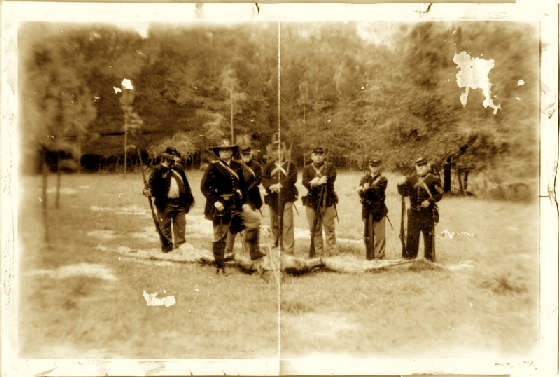
This photo shows Union soldiers during the Civil War
standing over the corpse of an unknown species of giant bird.
This photo is reputed to be of the so-called "Thunderbird" of American
Indian myth.
Quillayute
The Quillayute is a Chimakoan tribe living along the Quillayute
River, a six-mile river on the Olympic Peninsula. The fishing village of
Lapush is at its mouth.
These stories are adapted from Indian Legends of the Pacific
Northwest by Ella E. Clark, University of California Press, 1953.
Long ago, there was a sad time in the land of the Quillayute. For
days and days, great storms blew. Rain and hail and then sleet and snow
came down upon the land. The hailstones were so large that many of the
people were killed. The other Quillayute were driven from their coast
villages to the great prairie, which was the highest part of their land.
There the people grew thin and weak from hunger. The hailstones had
beaten down the ferns, the camas, and the berries. Ice locked the rivers
so the men could not fish. Storms rocked the ocean so the fishermen could
not go out in their canoes for deep-sea fishing. Soon, the people had
eaten all the grass and roots on the prairie; there was no food left. As
children died without food, even the strongest and bravest of their
fathers could do nothing. They called upon the Great Spirit for help, but
no help came.
At last the Great Chief of the Quillayute called a meeting of his
people. He was old and wise. "Take comfort, my people," the Chief said.
"We will call again upon the Great Spirit for help. If no help comes, then
we will know it is His will that we die. If it is not His will that we
live, then we will die bravely, as brave Quillayute have always died. Let
us talk with the Great Spirit."
So the weak and hungry people sat in silence while the Chief talked
with the Great Spirit, who had looked kindly upon the Quillayute for
hundreds of years.
When his prayer had ended, the Chief turned again to his people.
"Now we will wait for the will of the One who is wise and all-powerful."
The people waited. No one spoke. There was nothing but silence and
darkness. Suddenly, there came a great noise, and flashes of lightning cut
the darkness. A deep whirring sound, like giant wings beating, came from
the place of the setting sun. All of the people turned to gaze toward the
sky above the ocean as a huge, bird-shaped creature flew toward them.
This bird was larger than any they had ever seen. Its wings, from
tip to tip, were twice as long as a war canoe. It had a huge, curving
beak, and its eyes glowed like fire. The people saw that its great claws
held a living, giant whale.
In silence, they watched while Thunderbird - for so the bird was
named by everyone -carefully lowered the whale to the ground before them.
Thunderbird then flew high in the sky, and went back to the thunder and
lightning it had come from. Perhaps it flew back to its perch in the
hunting grounds of the Great Spirit.
Thunderbird and Whale saved the Quillayute from dying. The people
knew that the Great Spirit had heard their prayer. Even today they never
forget that visit from Thunderbird, never forget that it ended long days
of hunger and death. For on the prairie near their village are big, round
stones that the grandfathers say are the hardened hailstones of that storm
long ago.
Thunderbird is a very large bird, with feathers as long as a canoe
paddle. When he flaps his wings, he makes thunder and the great winds.
When he opens and shuts his eyes, he makes lightning. In stormy weather,
he flies through the skies, flapping his wings and opening and closing his
eyes.
Thunderbird's home is a cave in the Olympic Mountains, and he wants
no one to come near it. If hunters get close enough so he can smell them,
he makes thunder noise, and he rolls ice out of his cave. The ice rolls
down the mountainside, and when it reaches a rocky place, it breaks into
many pieces. The pieces rattle as they roll farther down into the valley.
All the hunters are so afraid of Thunderbird and his noise and
rolling ice that they never stay long near his home. No one ever sleeps
near his cave.
Thunderbird keeps his food in a dark hole at the edge of a big field
of ice and snow. His food is the whale. Thunderbird flies out of the
ocean, catches a whale and hurries back to the mountains to eat it. One
time Whale fought Thunderbird so hard that during the battle, trees were
torn up by their roots. To this day there are no trees in Beaver Prairie
because of the fight Whale and Thunderbird had that day.
At the time of the Great Flood, Thunderbird fought a long, long
battle with Killer Whale. He would catch Killer Whale in his claws and
start with him to the cave in the mountains. Killer Whale would escape and
return to the water. Thunderbird would catch him again, all the time
flashing lightning from his eyes and flapping his wings to create thunder.
Mountains were shaken by the noise, and trees were uprooted in their
struggle.
Again and again Killer Whale escaped. Again and again Thunderbird
seized him. Many times they fought, in different places in the mountains.
At last Killer Whale escaped to the middle of the ocean, and Thunderbird
gave up the fight.
That is why Killer Whales live in the deep oceans today. That is why
there are many prairies in the midst of the forests on the Olympic
Peninsula.
Back to
Atmospheric Sciences Home
Harry Edmonn
(harry@atmos.washington.edu)
|








.gif)








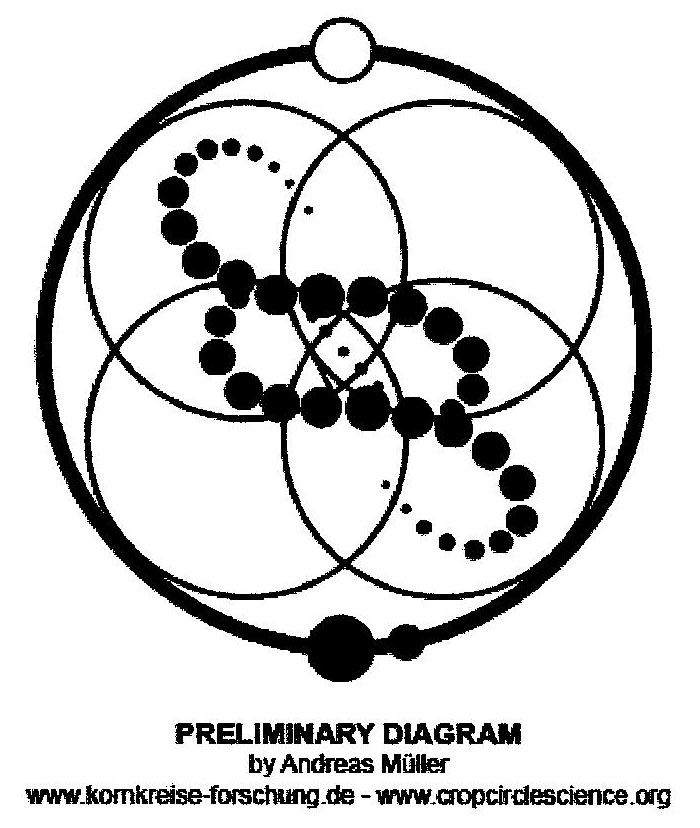
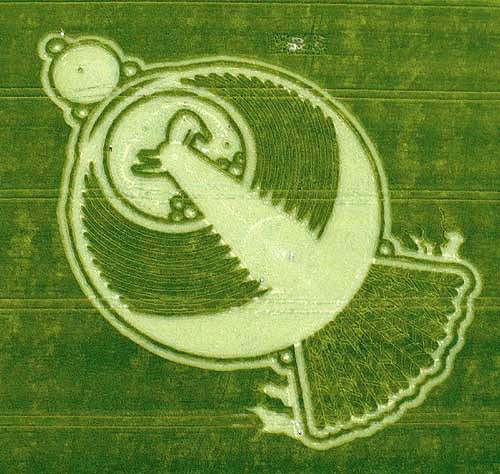



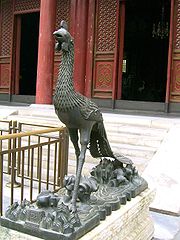


 Like
the sun god, the Benu's own birth is attributed to self
generation. A mythological papyri of the
Like
the sun god, the Benu's own birth is attributed to self
generation. A mythological papyri of the
 At
At
 The
bird was frequently depicted in the vignettes of the netherworld
books as well as on heart
The
bird was frequently depicted in the vignettes of the netherworld
books as well as on heart
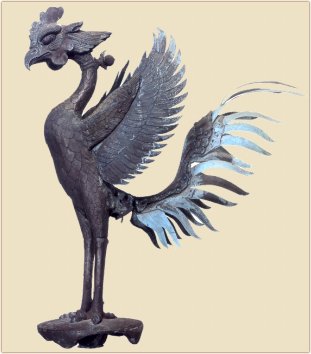







 CHINESE
LORE
CHINESE
LORE South
- the Red Bird
South
- the Red Bird PHOENIX
HISTORY, CHINA
PHOENIX
HISTORY, CHINA The
symbol of the Fenice has been used on objects in
China, often in jade, for over 7,000 years,
originally on good-luck totems, and then, from
around 2,000 years ago to represent power sent from
the heavens to the Empress.
The
symbol of the Fenice has been used on objects in
China, often in jade, for over 7,000 years,
originally on good-luck totems, and then, from
around 2,000 years ago to represent power sent from
the heavens to the Empress.





